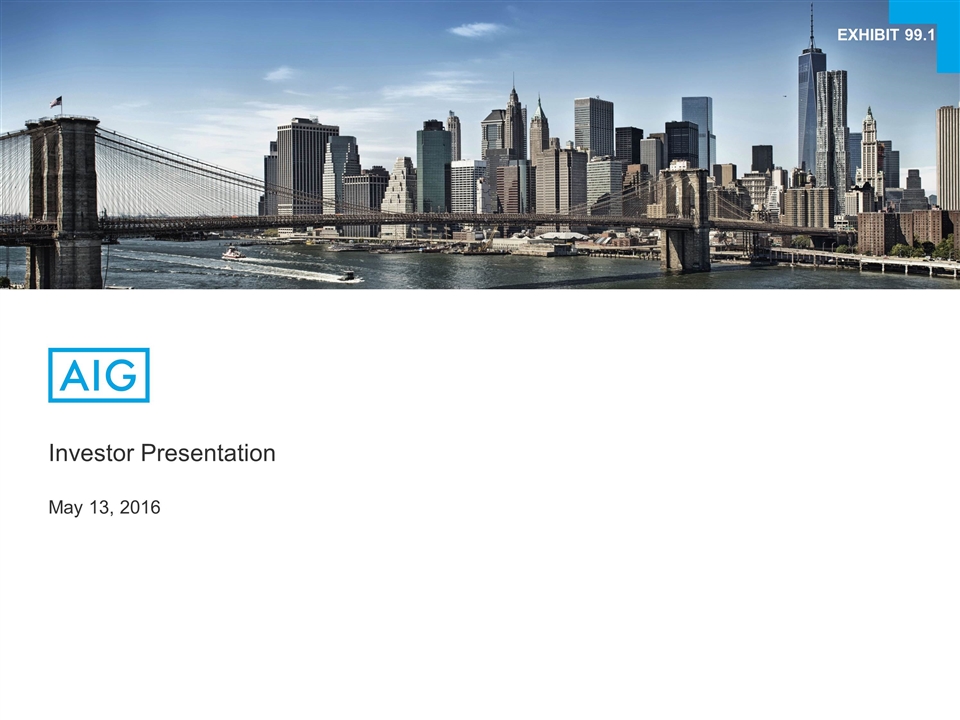
Investor Presentation May 13, 2016 EXHIBIT 99.1
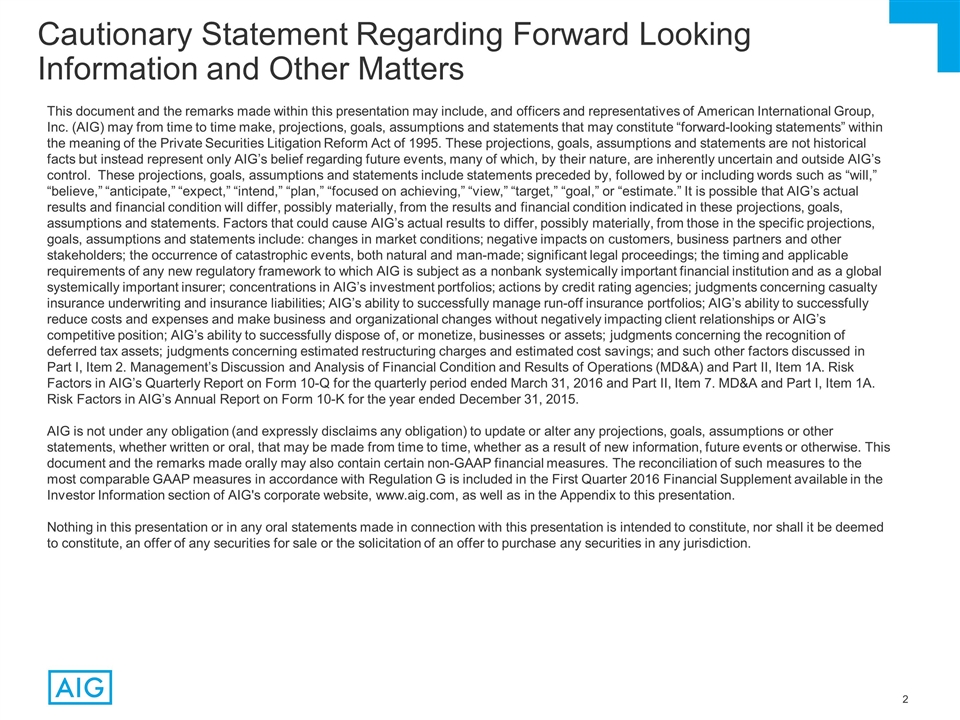
Cautionary Statement Regarding Forward Looking Information and Other Matters This document and the remarks made within this presentation may include, and officers and representatives of American International Group, Inc. (AIG) may from time to time make, projections, goals, assumptions and statements that may constitute “forward-looking statements” within the meaning of the Private Securities Litigation Reform Act of 1995. These projections, goals, assumptions and statements are not historical facts but instead represent only AIG’s belief regarding future events, many of which, by their nature, are inherently uncertain and outside AIG’s control. These projections, goals, assumptions and statements include statements preceded by, followed by or including words such as “will,” “believe,” “anticipate,” “expect,” “intend,” “plan,” “focused on achieving,” “view,” “target,” “goal,” or “estimate.” It is possible that AIG’s actual results and financial condition will differ, possibly materially, from the results and financial condition indicated in these projections, goals, assumptions and statements. Factors that could cause AIG’s actual results to differ, possibly materially, from those in the specific projections, goals, assumptions and statements include: changes in market conditions; negative impacts on customers, business partners and other stakeholders; the occurrence of catastrophic events, both natural and man-made; significant legal proceedings; the timing and applicable requirements of any new regulatory framework to which AIG is subject as a nonbank systemically important financial institution and as a global systemically important insurer; concentrations in AIG’s investment portfolios; actions by credit rating agencies; judgments concerning casualty insurance underwriting and insurance liabilities; AIG’s ability to successfully manage run-off insurance portfolios; AIG’s ability to successfully reduce costs and expenses and make business and organizational changes without negatively impacting client relationships or AIG’s competitive position; AIG’s ability to successfully dispose of, or monetize, businesses or assets; judgments concerning the recognition of deferred tax assets; judgments concerning estimated restructuring charges and estimated cost savings; and such other factors discussed in Part I, Item 2. Management’s Discussion and Analysis of Financial Condition and Results of Operations (MD&A) and Part II, Item 1A. Risk Factors in AIG’s Quarterly Report on Form 10-Q for the quarterly period ended March 31, 2016 and Part II, Item 7. MD&A and Part I, Item 1A. Risk Factors in AIG’s Annual Report on Form 10-K for the year ended December 31, 2015. AIG is not under any obligation (and expressly disclaims any obligation) to update or alter any projections, goals, assumptions or other statements, whether written or oral, that may be made from time to time, whether as a result of new information, future events or otherwise. This document and the remarks made orally may also contain certain non-GAAP financial measures. The reconciliation of such measures to the most comparable GAAP measures in accordance with Regulation G is included in the First Quarter 2016 Financial Supplement available in the Investor Information section of AIG's corporate website, www.aig.com, as well as in the Appendix to this presentation. Nothing in this presentation or in any oral statements made in connection with this presentation is intended to constitute, nor shall it be deemed to constitute, an offer of any securities for sale or the solicitation of an offer to purchase any securities in any jurisdiction.
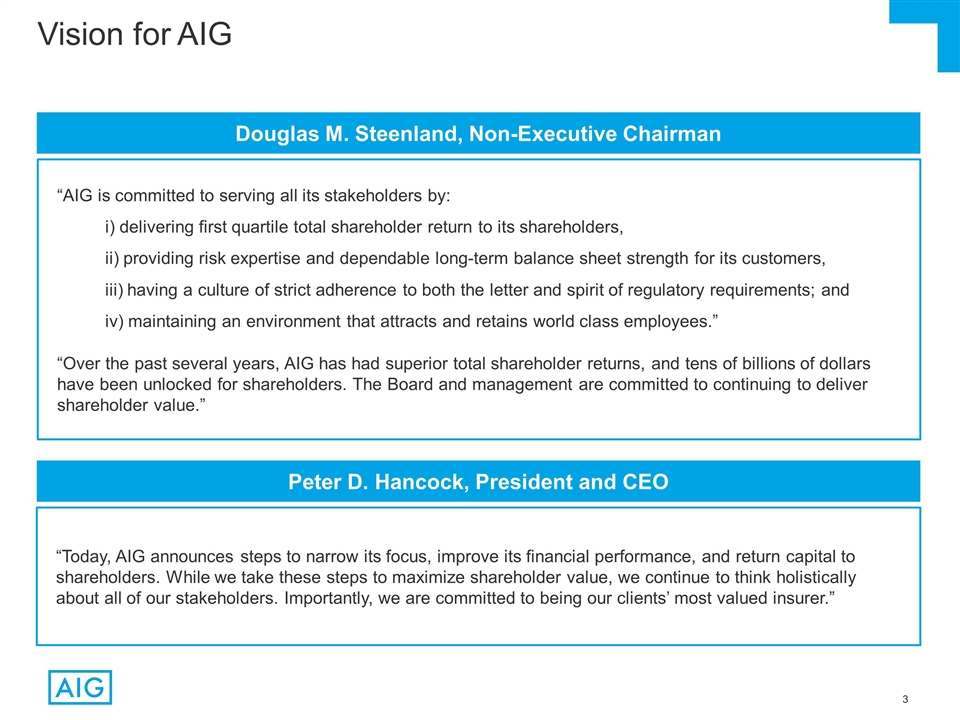
Vision for AIG “Today, AIG announces steps to narrow its focus, improve its financial performance, and return capital to shareholders. While we take these steps to maximize shareholder value, we continue to think holistically about all of our stakeholders. Importantly, we are committed to being our clients’ most valued insurer.” Peter D. Hancock, President and CEO “AIG is committed to serving all its stakeholders by: i) delivering first quartile total shareholder return to its shareholders, ii) providing risk expertise and dependable long-term balance sheet strength for its customers, iii) having a culture of strict adherence to both the letter and spirit of regulatory requirements; and iv) maintaining an environment that attracts and retains world class employees.” “Over the past several years, AIG has had superior total shareholder returns, and tens of billions of dollars have been unlocked for shareholders. The Board and management are committed to continuing to deliver shareholder value.” Douglas M. Steenland, Non-Executive Chairman
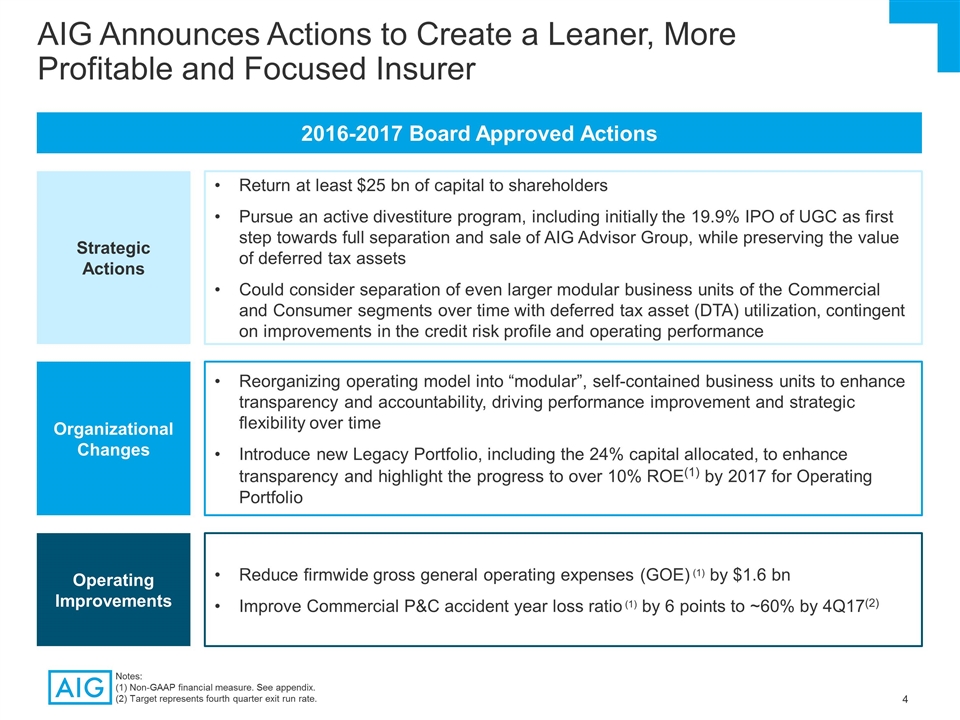
AIG Announces Actions to Create a Leaner, More Profitable and Focused Insurer 2016-2017 Board Approved Actions Return at least $25 bn of capital to shareholders Pursue an active divestiture program, including initially the 19.9% IPO of UGC as first step towards full separation and sale of AIG Advisor Group, while preserving the value of deferred tax assets Could consider separation of even larger modular business units of the Commercial and Consumer segments over time with deferred tax asset (DTA) utilization, contingent on improvements in the credit risk profile and operating performance Strategic Actions Reorganizing operating model into “modular”, self-contained business units to enhance transparency and accountability, driving performance improvement and strategic flexibility over time Introduce new Legacy Portfolio, including the 24% capital allocated, to enhance transparency and highlight the progress to over 10% ROE(1) by 2017 for Operating Portfolio Organizational Changes Reduce firmwide gross general operating expenses (GOE) (1) by $1.6 bn Improve Commercial P&C accident year loss ratio (1) by 6 points to ~60% by 4Q17(2) Operating Improvements Notes: (1) Non-GAAP financial measure. See appendix. (2) Target represents fourth quarter exit run rate.
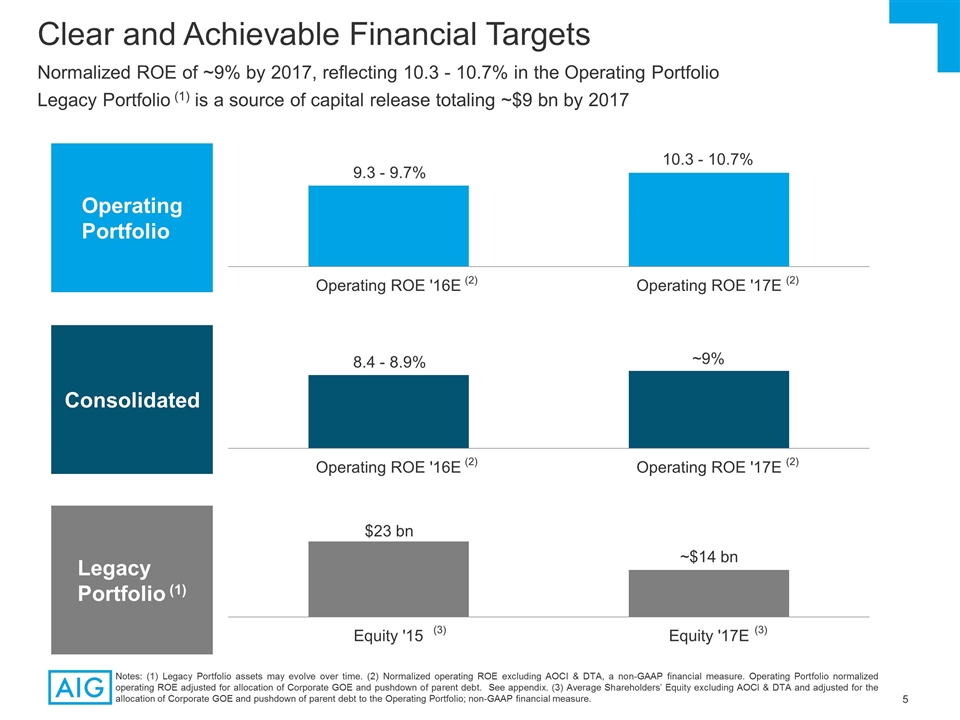
Clear and Achievable Financial Targets Operating Portfolio Legacy Portfolio (1) Consolidated ~$14 bn $23 bn 10.3 - 10.7% 9.3 - 9.7% ~9% 8.4 - 8.9% (2) (2) Notes: (1) Legacy Portfolio assets may evolve over time. (2) Normalized operating ROE excluding AOCI & DTA, a non-GAAP financial measure. Operating Portfolio normalized operating ROE adjusted for allocation of Corporate GOE and pushdown of parent debt. See appendix. (3) Average Shareholders’ Equity excluding AOCI & DTA and adjusted for the allocation of Corporate GOE and pushdown of parent debt to the Operating Portfolio; non-GAAP financial measure. (2) (2) Normalized ROE of ~9% by 2017, reflecting 10.3 - 10.7% in the Operating Portfolio Legacy Portfolio (1) is a source of capital release totaling ~$9 bn by 2017 (3) (3)
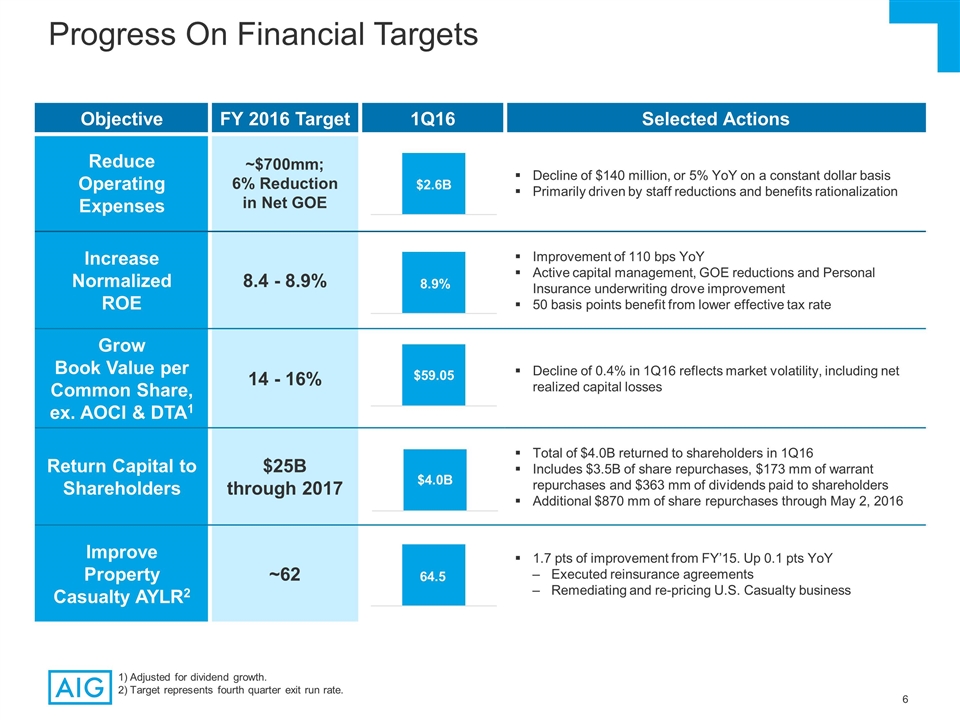
Progress On Financial Targets Objective FY 2016 Target 1Q16 Selected Actions Reduce Operating Expenses ~$700mm; 6% Reduction in Net GOE Decline of $140 million, or 5% YoY on a constant dollar basis Primarily driven by staff reductions and benefits rationalization Increase Normalized ROE 8.4 - 8.9% Improvement of 110 bps YoY Active capital management, GOE reductions and Personal Insurance underwriting drove improvement 50 basis points benefit from lower effective tax rate Grow Book Value per Common Share, ex. AOCI & DTA1 14 - 16% Decline of 0.4% in 1Q16 reflects market volatility, including net realized capital losses Return Capital to Shareholders $25B through 2017 Total of $4.0B returned to shareholders in 1Q16 Includes $3.5B of share repurchases, $173 mm of warrant repurchases and $363 mm of dividends paid to shareholders Additional $870 mm of share repurchases through May 2, 2016 Improve Property Casualty AYLR2 ~62 1.7 pts of improvement from FY’15. Up 0.1 pts YoY Executed reinsurance agreements Remediating and re-pricing U.S. Casualty business Adjusted for dividend growth. Target represents fourth quarter exit run rate. $2.6B 8.9% $59.05 $4.0B 64.5
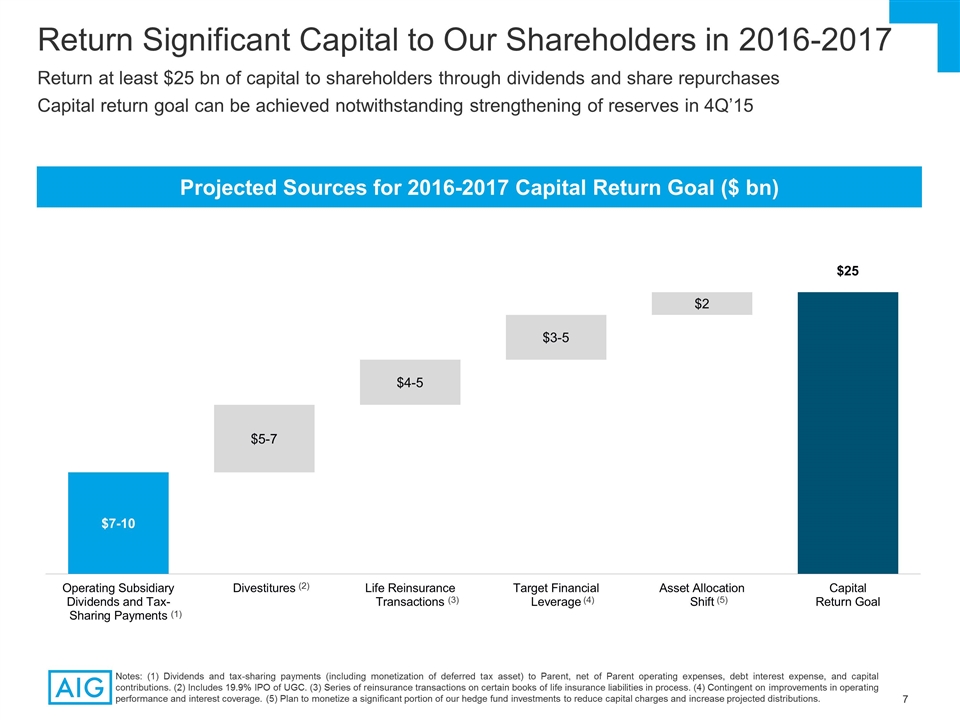
Return Significant Capital to Our Shareholders in 2016-2017 Projected Sources for 2016-2017 Capital Return Goal ($ bn) Return at least $25 bn of capital to shareholders through dividends and share repurchases Capital return goal can be achieved notwithstanding strengthening of reserves in 4Q’15 (3) (4) Notes: (1) Dividends and tax-sharing payments (including monetization of deferred tax asset) to Parent, net of Parent operating expenses, debt interest expense, and capital contributions. (2) Includes 19.9% IPO of UGC. (3) Series of reinsurance transactions on certain books of life insurance liabilities in process. (4) Contingent on improvements in operating performance and interest coverage. (5) Plan to monetize a significant portion of our hedge fund investments to reduce capital charges and increase projected distributions. (5) (1) (2)
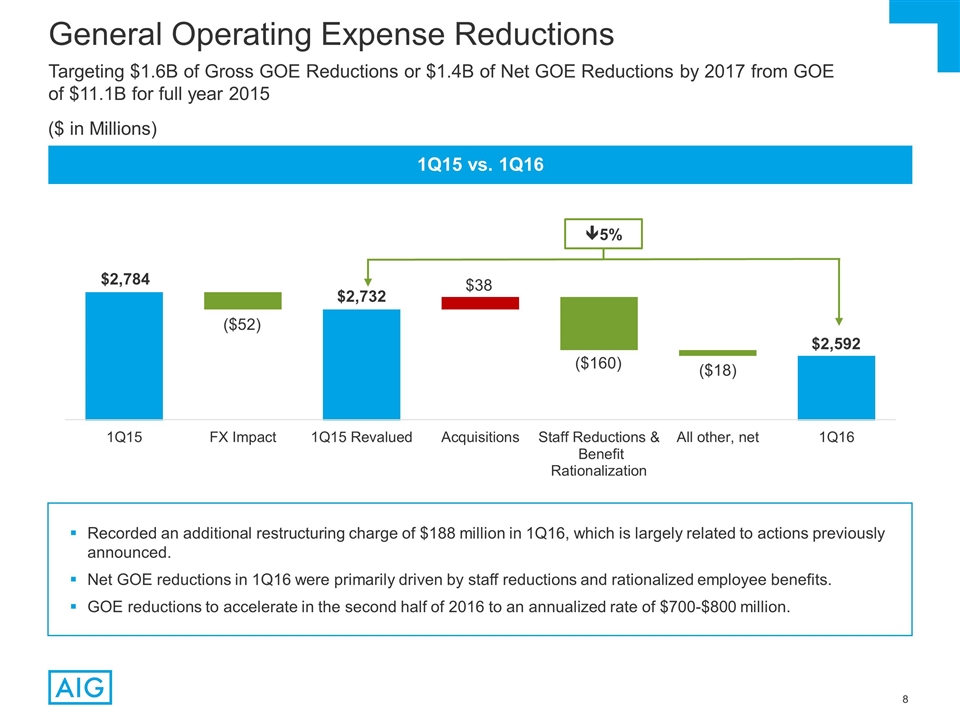
General Operating Expense Reductions Targeting $1.6B of Gross GOE Reductions or $1.4B of Net GOE Reductions by 2017 from GOE of $11.1B for full year 2015 1Q15 vs. 1Q16 ($ in Millions) ê5% Recorded an additional restructuring charge of $188 million in 1Q16, which is largely related to actions previously announced. Net GOE reductions in 1Q16 were primarily driven by staff reductions and rationalized employee benefits. GOE reductions to accelerate in the second half of 2016 to an annualized rate of $700-$800 million. $2,784 ($52) ($160) ($18) $2,732 $38 $2,592
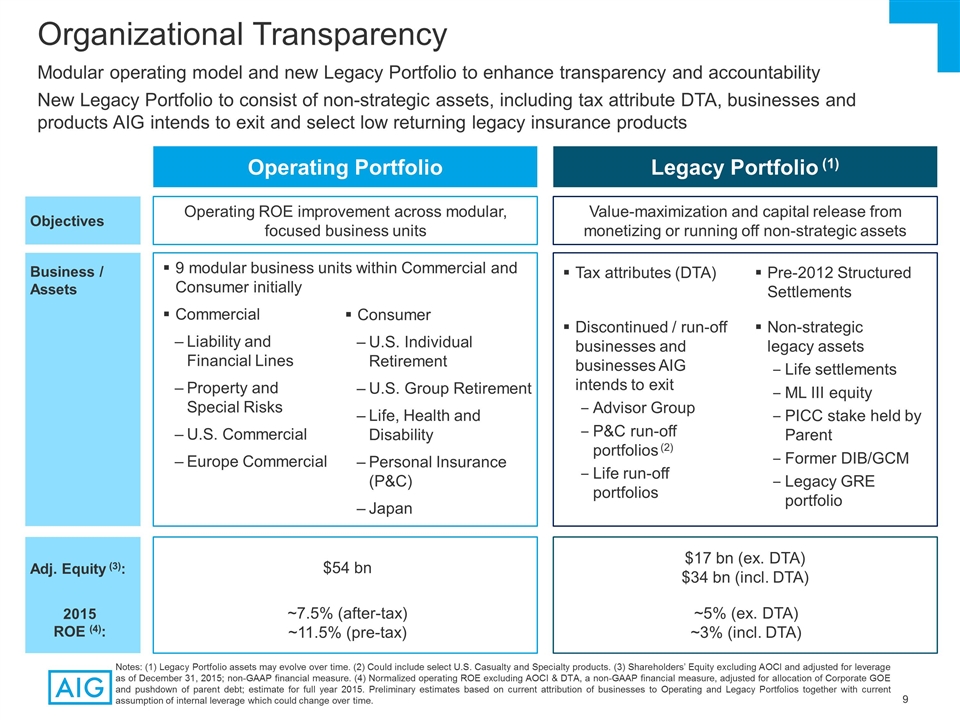
Organizational Transparency Operating Portfolio Legacy Portfolio (1) Objectives Value-maximization and capital release from monetizing or running off non-strategic assets Operating ROE improvement across modular, focused business units Notes: (1) Legacy Portfolio assets may evolve over time. (2) Could include select U.S. Casualty and Specialty products. (3) Shareholders’ Equity excluding AOCI and adjusted for leverage as of December 31, 2015; non-GAAP financial measure. (4) Normalized operating ROE excluding AOCI & DTA, a non-GAAP financial measure, adjusted for allocation of Corporate GOE and pushdown of parent debt; estimate for full year 2015. Preliminary estimates based on current attribution of businesses to Operating and Legacy Portfolios together with current assumption of internal leverage which could change over time. Modular operating model and new Legacy Portfolio to enhance transparency and accountability New Legacy Portfolio to consist of non-strategic assets, including tax attribute DTA, businesses and products AIG intends to exit and select low returning legacy insurance products Business / Assets Tax attributes (DTA) Discontinued / run-off businesses and businesses AIG intends to exit Advisor Group P&C run-off portfolios (2) Life run-off portfolios Pre-2012 Structured Settlements Non-strategic legacy assets Life settlements ML III equity PICC stake held by Parent Former DIB/GCM Legacy GRE portfolio 9 modular business units within Commercial and Consumer initially Commercial Liability and Financial Lines Property and Special Risks U.S. Commercial Europe Commercial Consumer U.S. Individual Retirement U.S. Group Retirement Life, Health and Disability Personal Insurance (P&C) Japan Adj. Equity (3): ~7.5% (after-tax) ~11.5% (pre-tax) ~5% (ex. DTA) ~3% (incl. DTA) 2015 ROE (4): $54 bn $17 bn (ex. DTA) $34 bn (incl. DTA)
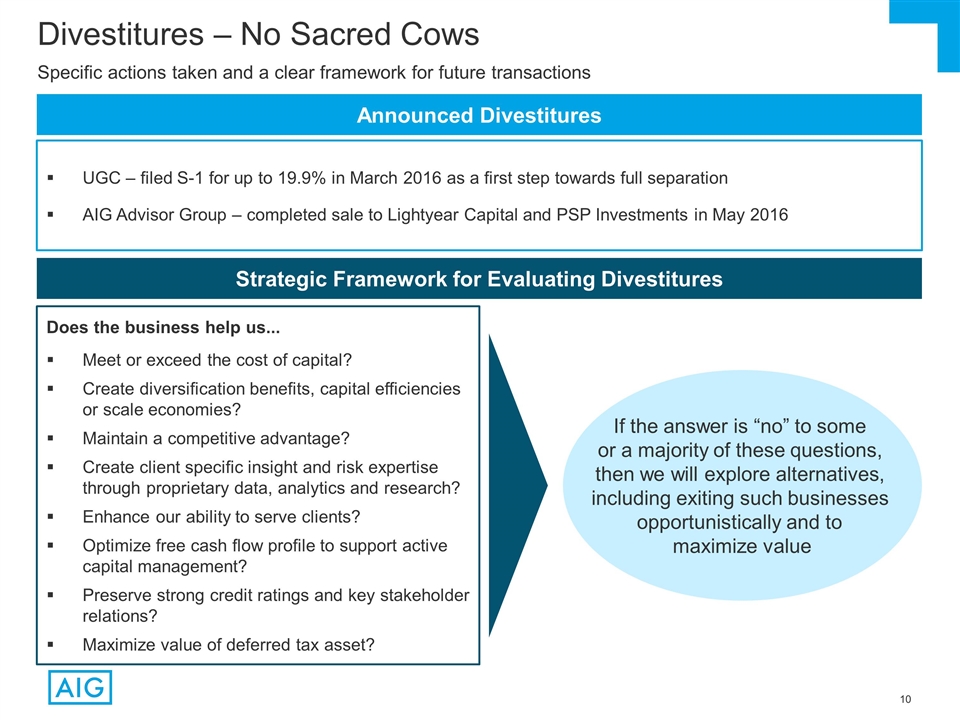
UGC – filed S-1 for up to 19.9% in March 2016 as a first step towards full separation AIG Advisor Group – completed sale to Lightyear Capital and PSP Investments in May 2016 Divestitures – No Sacred Cows Announced Divestitures Does the business help us... Meet or exceed the cost of capital? Create diversification benefits, capital efficiencies or scale economies? Maintain a competitive advantage? Create client specific insight and risk expertise through proprietary data, analytics and research? Enhance our ability to serve clients? Optimize free cash flow profile to support active capital management? Preserve strong credit ratings and key stakeholder relations? Maximize value of deferred tax asset? Strategic Framework for Evaluating Divestitures Specific actions taken and a clear framework for future transactions If the answer is “no” to some or a majority of these questions, then we will explore alternatives, including exiting such businesses opportunistically and to maximize value
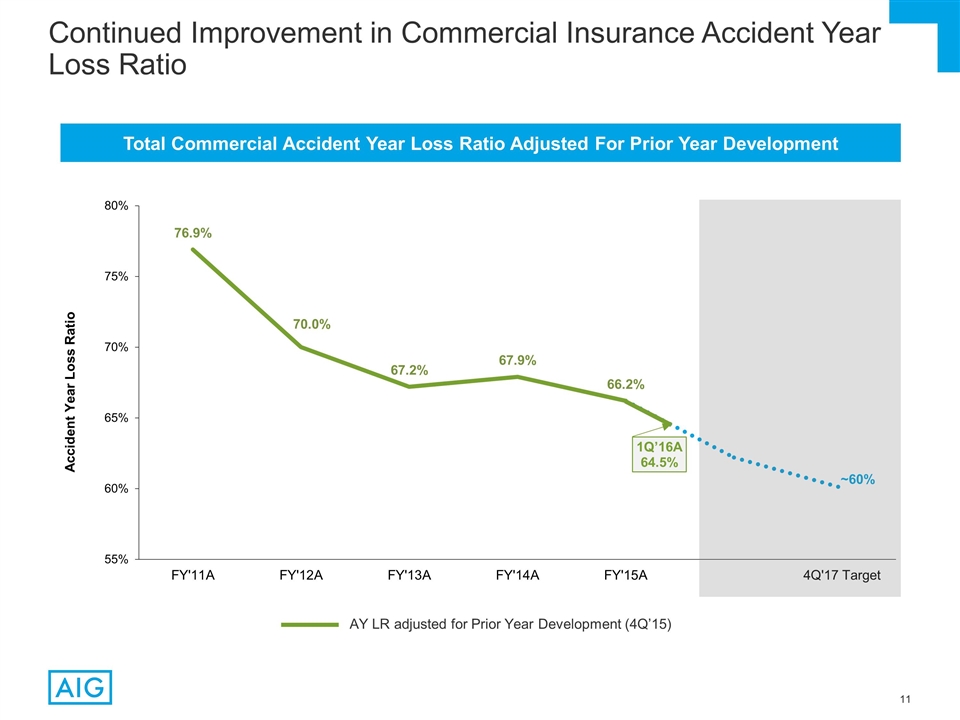
Continued Improvement in Commercial Insurance Accident Year Loss Ratio Total Commercial Accident Year Loss Ratio Adjusted For Prior Year Development AY LR adjusted for Prior Year Development (4Q’15)
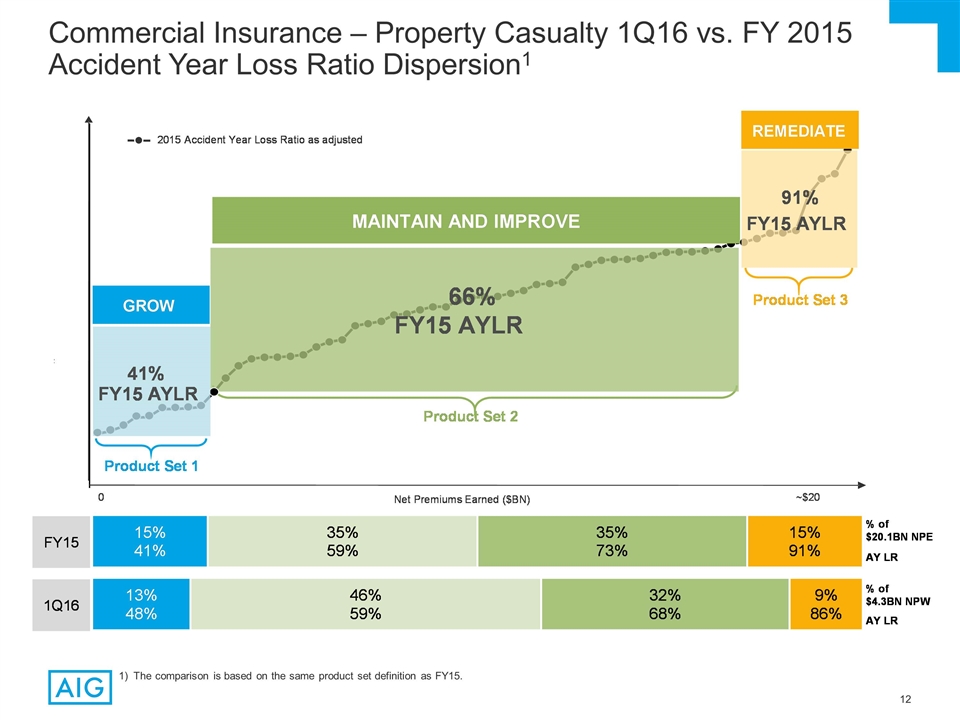
Commercial Insurance – Property Casualty 1Q16 vs. FY 2015 Accident Year Loss Ratio Dispersion1 The comparison is based on the same product set definition as FY15.
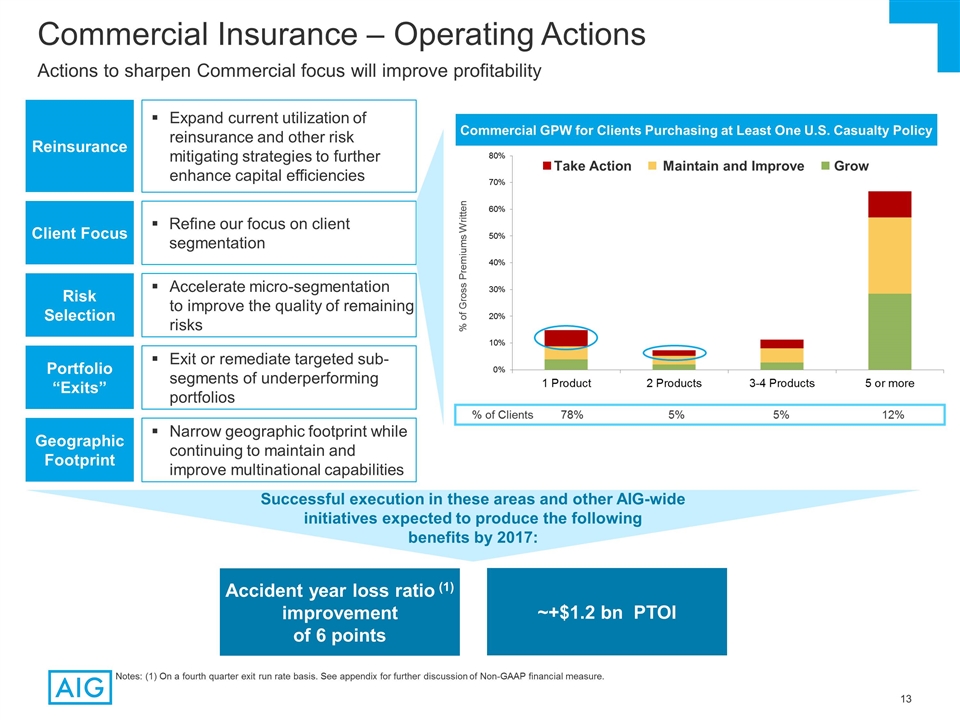
Client Focus Refine our focus on client segmentation Successful execution in these areas and other AIG-wide initiatives expected to produce the following benefits by 2017: ~+$1.2 bn PTOI Accident year loss ratio (1) improvement of 6 points Portfolio “Exits” Exit or remediate targeted sub-segments of underperforming portfolios Reinsurance Expand current utilization of reinsurance and other risk mitigating strategies to further enhance capital efficiencies Risk Selection Accelerate micro-segmentation to improve the quality of remaining risks Commercial Insurance – Operating Actions Actions to sharpen Commercial focus will improve profitability Maintain and Improve Take Action Grow Geographic Footprint Narrow geographic footprint while continuing to maintain and improve multinational capabilities Commercial GPW for Clients Purchasing at Least One U.S. Casualty Policy Notes: (1) On a fourth quarter exit run rate basis. See appendix for further discussion of Non-GAAP financial measure.
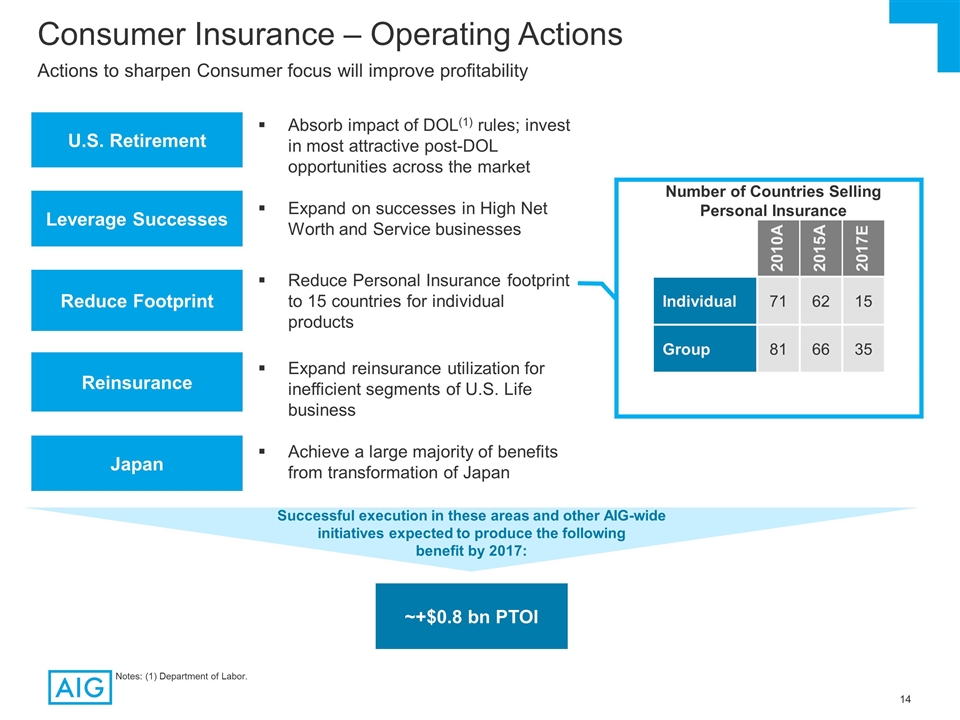
Actions to sharpen Consumer focus will improve profitability Leverage Successes Japan Reinsurance Expand on successes in High Net Worth and Service businesses Reduce Footprint Successful execution in these areas and other AIG-wide initiatives expected to produce the following benefit by 2017: ~+$0.8 bn PTOI 2010A 2015A 2017E Individual 71 62 15 Group 81 66 35 Number of Countries Selling Personal Insurance Reduce Personal Insurance footprint to 15 countries for individual products Expand reinsurance utilization for inefficient segments of U.S. Life business Achieve a large majority of benefits from transformation of Japan U.S. Retirement Absorb impact of DOL(1) rules; invest in most attractive post-DOL opportunities across the market Consumer Insurance – Operating Actions Notes: (1) Department of Labor.
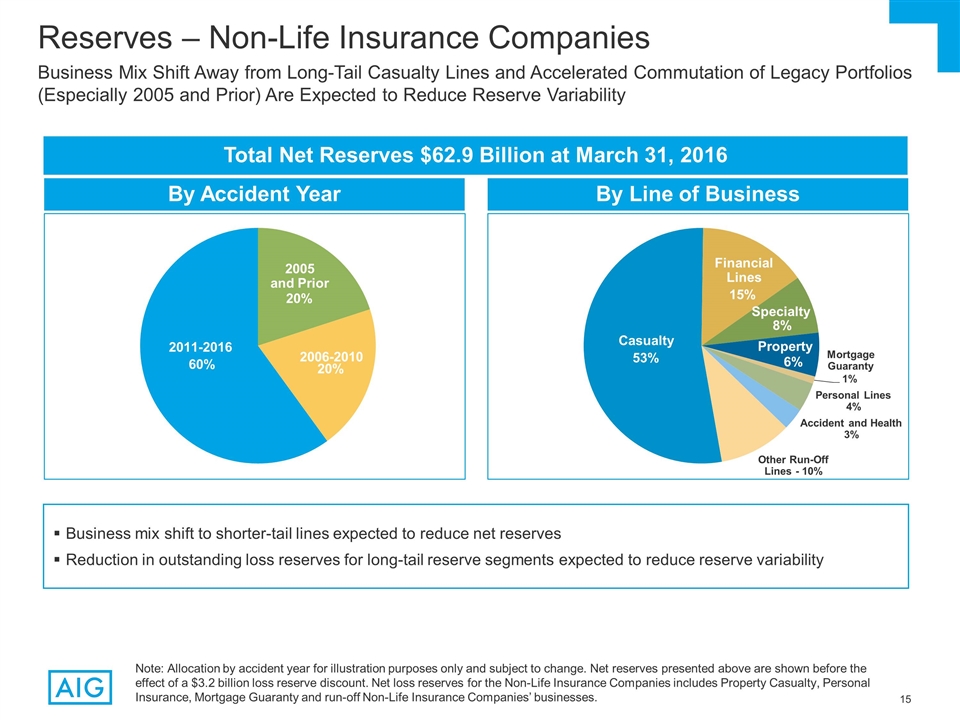
Reserves – Non-Life Insurance Companies Business mix shift to shorter-tail lines expected to reduce net reserves Reduction in outstanding loss reserves for long-tail reserve segments expected to reduce reserve variability Note: Allocation by accident year for illustration purposes only and subject to change. Net reserves presented above are shown before the effect of a $3.2 billion loss reserve discount. Net loss reserves for the Non-Life Insurance Companies includes Property Casualty, Personal Insurance, Mortgage Guaranty and run-off Non-Life Insurance Companies’ businesses. Total Net Reserves $62.9 Billion at March 31, 2016 2005 and Prior 2011-2016 2006-2010 Casualty Financial Lines Specialty Property Mortgage Guaranty Personal Lines 4% Accident and Health 3% Other Run-Off Lines - 10% By Accident Year By Line of Business Business Mix Shift Away from Long-Tail Casualty Lines and Accelerated Commutation of Legacy Portfolios (Especially 2005 and Prior) Are Expected to Reduce Reserve Variability
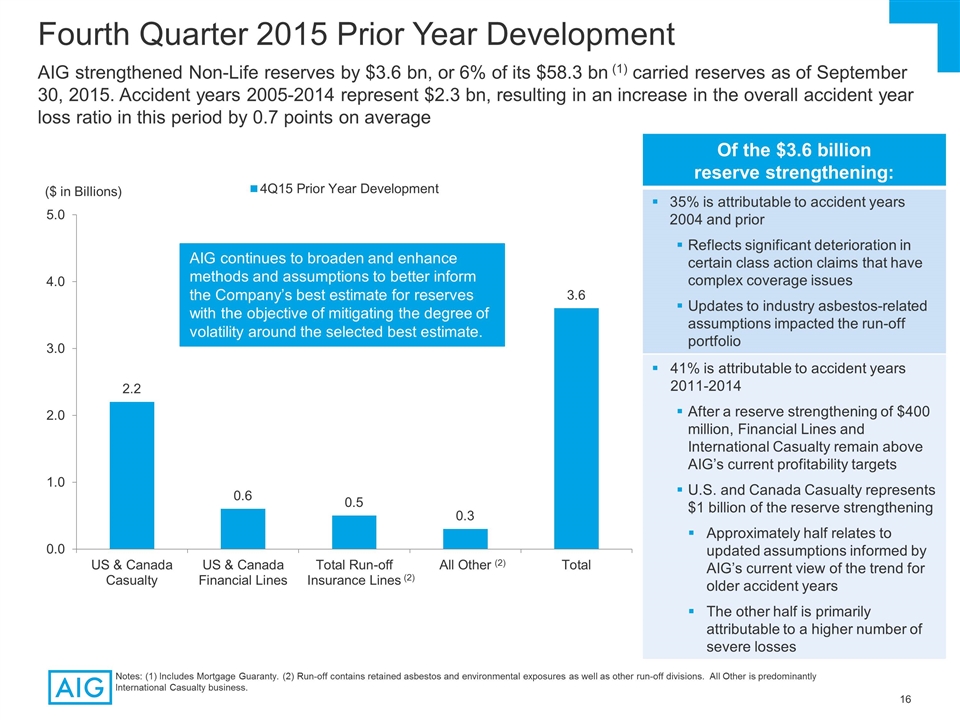
AIG continues to broaden and enhance methods and assumptions to better inform the Company’s best estimate for reserves with the objective of mitigating the degree of volatility around the selected best estimate. Of the $3.6 billion reserve strengthening: 35% is attributable to accident years 2004 and prior Reflects significant deterioration in certain class action claims that have complex coverage issues Updates to industry asbestos-related assumptions impacted the run-off portfolio 41% is attributable to accident years 2011-2014 After a reserve strengthening of $400 million, Financial Lines and International Casualty remain above AIG’s current profitability targets U.S. and Canada Casualty represents $1 billion of the reserve strengthening Approximately half relates to updated assumptions informed by AIG’s current view of the trend for older accident years The other half is primarily attributable to a higher number of severe losses ($ in Billions) Fourth Quarter 2015 Prior Year Development AIG strengthened Non-Life reserves by $3.6 bn, or 6% of its $58.3 bn (1) carried reserves as of September 30, 2015. Accident years 2005-2014 represent $2.3 bn, resulting in an increase in the overall accident year loss ratio in this period by 0.7 points on average Notes: (1) Includes Mortgage Guaranty. (2) Run-off contains retained asbestos and environmental exposures as well as other run-off divisions. All Other is predominantly International Casualty business. (2) (2)
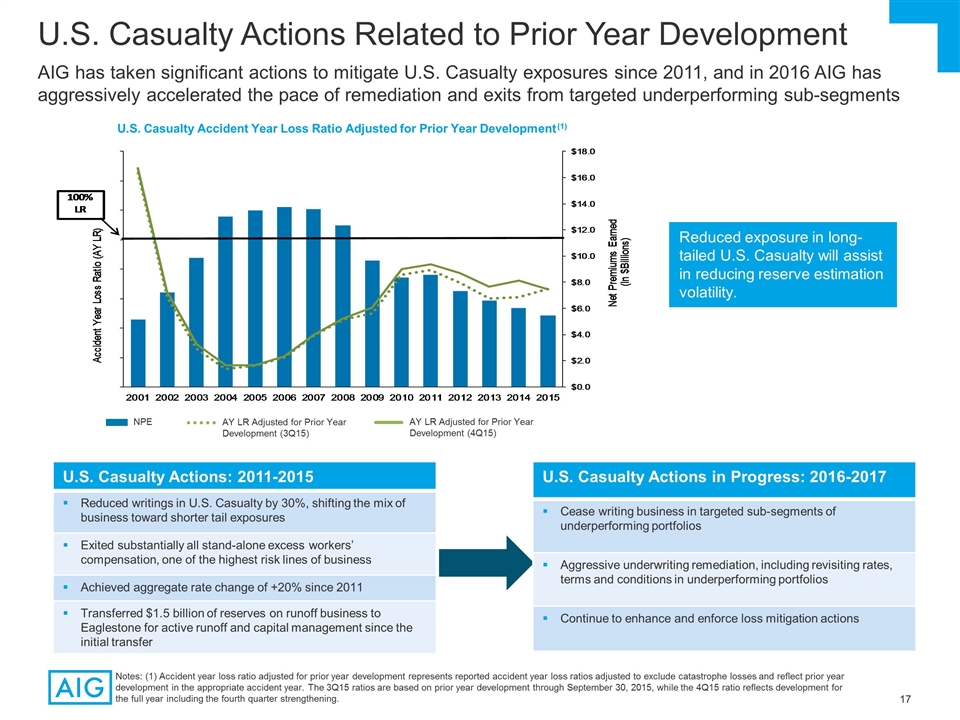
Reduced exposure in long-tailed U.S. Casualty will assist in reducing reserve estimation volatility. U.S. Casualty Actions Related to Prior Year Development AIG has taken significant actions to mitigate U.S. Casualty exposures since 2011, and in 2016 AIG has aggressively accelerated the pace of remediation and exits from targeted underperforming sub-segments NPE AY LR Adjusted for Prior Year Development (3Q15) AY LR Adjusted for Prior Year Development (4Q15) Notes: (1) Accident year loss ratio adjusted for prior year development represents reported accident year loss ratios adjusted to exclude catastrophe losses and reflect prior year development in the appropriate accident year. The 3Q15 ratios are based on prior year development through September 30, 2015, while the 4Q15 ratio reflects development for the full year including the fourth quarter strengthening. U.S. Casualty Actions: 2011-2015 Reduced writings in U.S. Casualty by 30%, shifting the mix of business toward shorter tail exposures Exited substantially all stand-alone excess workers’ compensation, one of the highest risk lines of business Achieved aggregate rate change of +20% since 2011 Transferred $1.5 billion of reserves on runoff business to Eaglestone for active runoff and capital management since the initial transfer U.S. Casualty Actions in Progress: 2016-2017 Cease writing business in targeted sub-segments of underperforming portfolios Aggressive underwriting remediation, including revisiting rates, terms and conditions in underperforming portfolios Continue to enhance and enforce loss mitigation actions U.S. Casualty Accident Year Loss Ratio Adjusted for Prior Year Development (1)
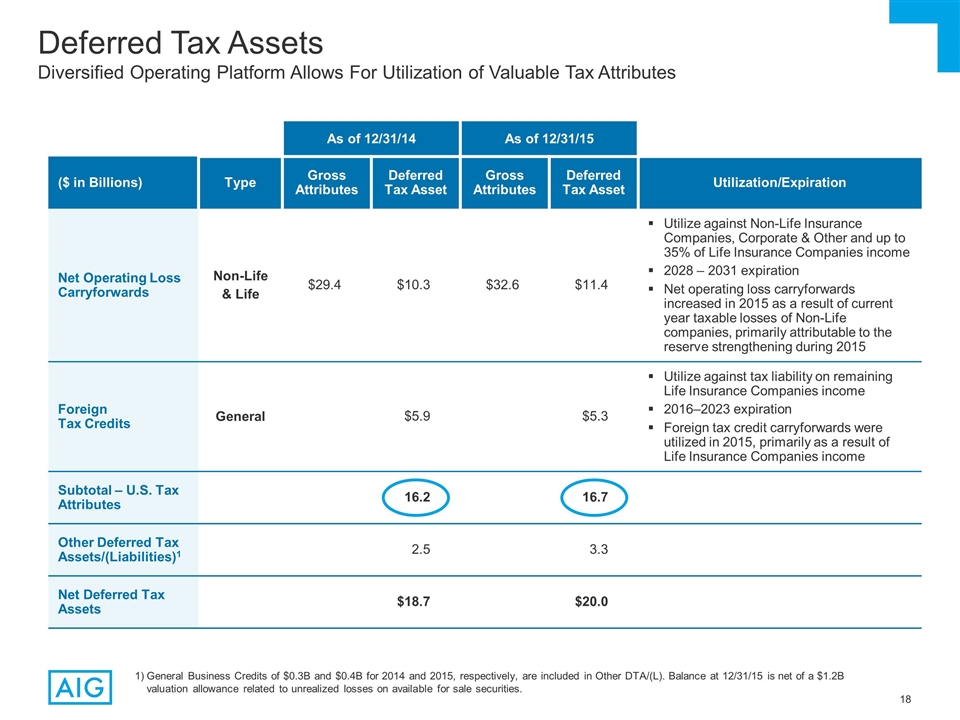
Deferred Tax Assets As of 12/31/14 As of 12/31/15 ($ in Billions) Type Gross Attributes Deferred Tax Asset Gross Attributes Deferred Tax Asset Utilization/Expiration Net Operating Loss Carryforwards Non-Life & Life $29.4 $10.3 $32.6 $11.4 Utilize against Non-Life Insurance Companies, Corporate & Other and up to 35% of Life Insurance Companies income 2028 – 2031 expiration Net operating loss carryforwards increased in 2015 as a result of current year taxable losses of Non-Life companies, primarily attributable to the reserve strengthening during 2015 Foreign Tax Credits General $5.9 $5.3 Utilize against tax liability on remaining Life Insurance Companies income 2016–2023 expiration Foreign tax credit carryforwards were utilized in 2015, primarily as a result of Life Insurance Companies income Subtotal – U.S. Tax Attributes 16.2 16.7 Other Deferred Tax Assets/(Liabilities)1 2.5 3.3 Net Deferred Tax Assets $18.7 $20.0 Diversified Operating Platform Allows For Utilization of Valuable Tax Attributes General Business Credits of $0.3B and $0.4B for 2014 and 2015, respectively, are included in Other DTA/(L). Balance at 12/31/15 is net of a $1.2B valuation allowance related to unrealized losses on available for sale securities.
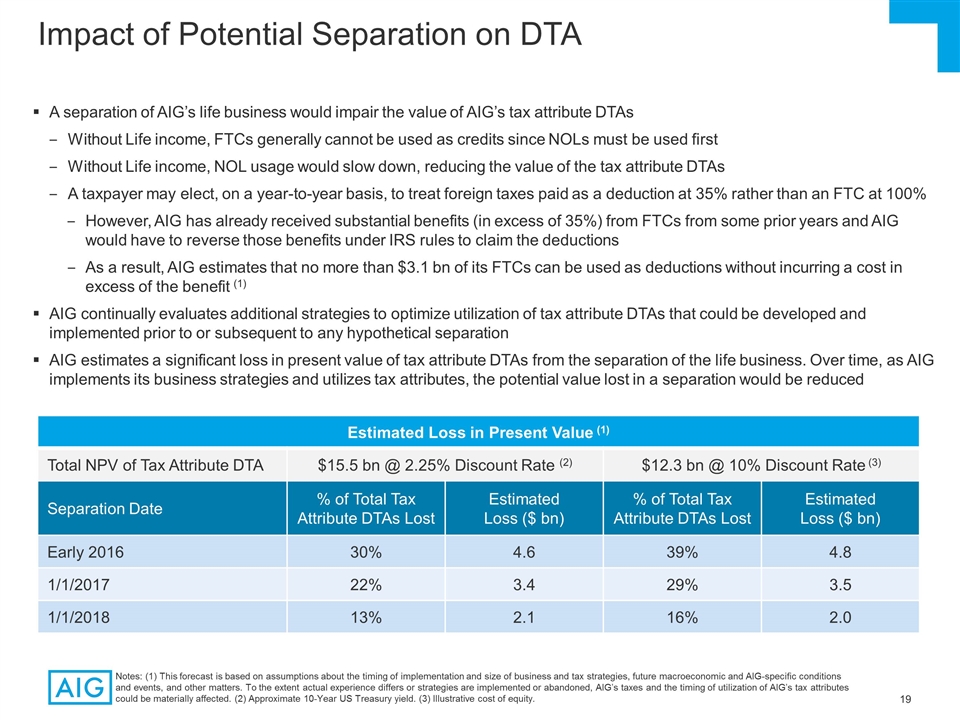
Impact of Potential Separation on DTA A separation of AIG’s life business would impair the value of AIG’s tax attribute DTAs Without Life income, FTCs generally cannot be used as credits since NOLs must be used first Without Life income, NOL usage would slow down, reducing the value of the tax attribute DTAs A taxpayer may elect, on a year-to-year basis, to treat foreign taxes paid as a deduction at 35% rather than an FTC at 100% However, AIG has already received substantial benefits (in excess of 35%) from FTCs from some prior years and AIG would have to reverse those benefits under IRS rules to claim the deductions As a result, AIG estimates that no more than $3.1 bn of its FTCs can be used as deductions without incurring a cost in excess of the benefit (1) AIG continually evaluates additional strategies to optimize utilization of tax attribute DTAs that could be developed and implemented prior to or subsequent to any hypothetical separation AIG estimates a significant loss in present value of tax attribute DTAs from the separation of the life business. Over time, as AIG implements its business strategies and utilizes tax attributes, the potential value lost in a separation would be reduced Notes: (1) This forecast is based on assumptions about the timing of implementation and size of business and tax strategies, future macroeconomic and AIG-specific conditions and events, and other matters. To the extent actual experience differs or strategies are implemented or abandoned, AIG’s taxes and the timing of utilization of AIG’s tax attributes could be materially affected. (2) Approximate 10-Year US Treasury yield. (3) Illustrative cost of equity. Estimated Loss in Present Value (1) Total NPV of Tax Attribute DTA $15.5 bn @ 2.25% Discount Rate (2) $12.3 bn @ 10% Discount Rate (3) Separation Date % of Total Tax Attribute DTAs Lost Estimated Loss ($ bn) % of Total Tax Attribute DTAs Lost Estimated Loss ($ bn) Early 2016 30% 4.6 39% 4.8 1/1/2017 22% 3.4 29% 3.5 1/1/2018 13% 2.1 16% 2.0
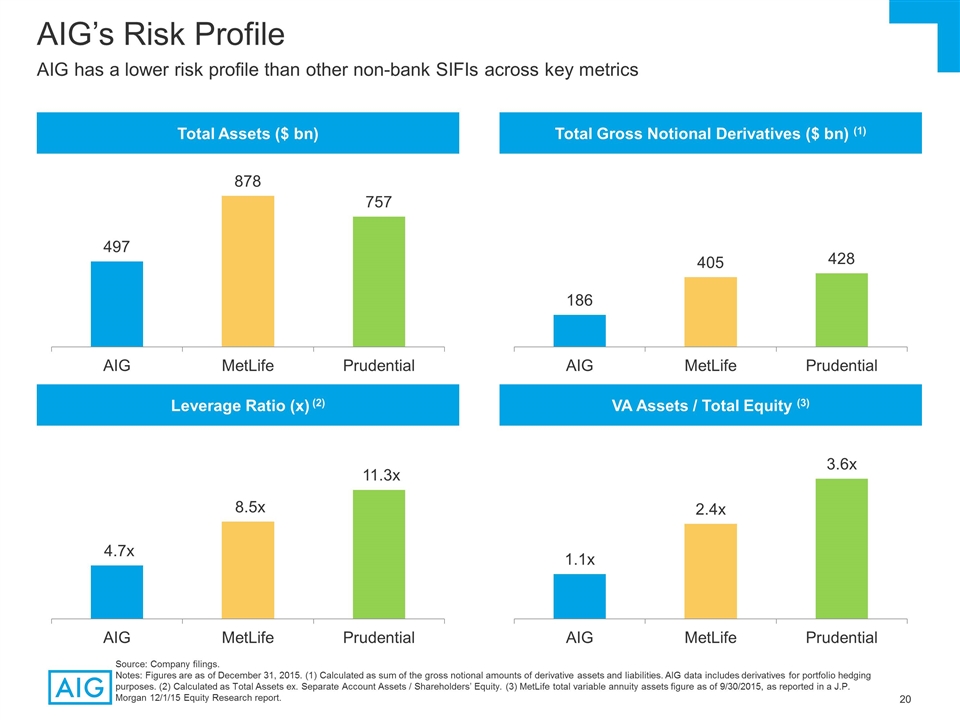
AIG’s Risk Profile Total Assets ($ bn) Total Gross Notional Derivatives ($ bn) (1) Leverage Ratio (x) (2) VA Assets / Total Equity (3) Source: Company filings. Notes: Figures are as of December 31, 2015. (1) Calculated as sum of the gross notional amounts of derivative assets and liabilities. AIG data includes derivatives for portfolio hedging purposes. (2) Calculated as Total Assets ex. Separate Account Assets / Shareholders’ Equity. (3) MetLife total variable annuity assets figure as of 9/30/2015, as reported in a J.P. Morgan 12/1/15 Equity Research report. AIG has a lower risk profile than other non-bank SIFIs across key metrics
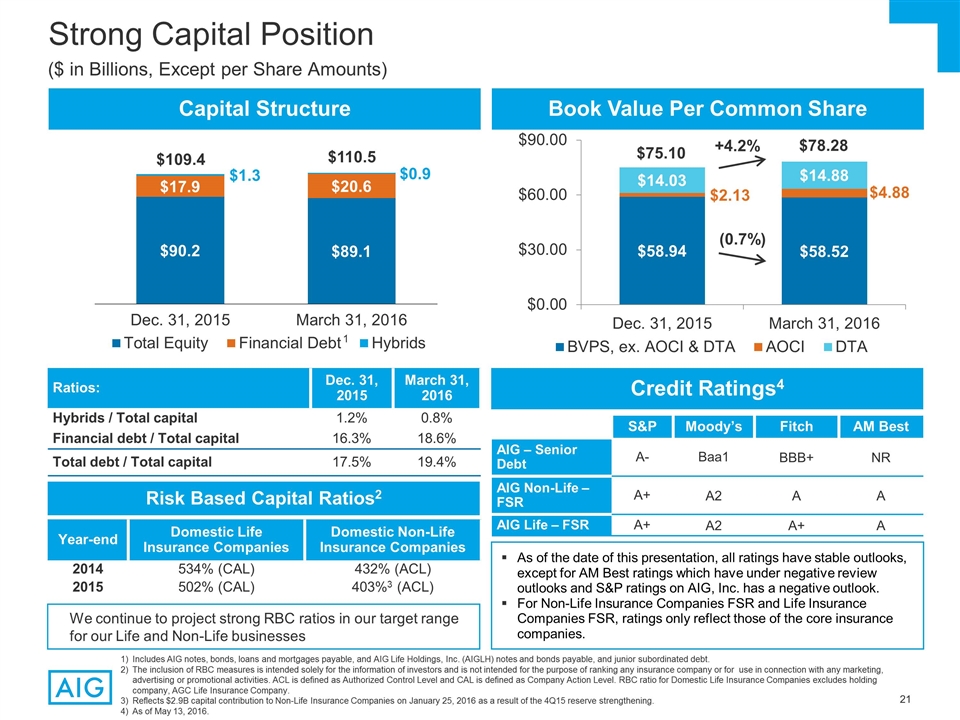
21 ($ in Billions, Except per Share Amounts) Book Value Per Common Share $75.10 (0.7%) $78.28 +4.2% Ratios: Dec. 31, 2015 March 31, 2016 Hybrids / Total capital 1.2% 0.8% Financial debt / Total capital 16.3% 18.6% Total debt / Total capital 17.5% 19.4% Capital Structure 1 $109.4 $110.5 Year-end Domestic Life Insurance Companies Domestic Non-Life Insurance Companies 2014 534% (CAL) 432% (ACL) 2015 502% (CAL) 403%3 (ACL) Risk Based Capital Ratios2 We continue to project strong RBC ratios in our target range for our Life and Non-Life businesses Strong Capital Position Includes AIG notes, bonds, loans and mortgages payable, and AIG Life Holdings, Inc. (AIGLH) notes and bonds payable, and junior subordinated debt. The inclusion of RBC measures is intended solely for the information of investors and is not intended for the purpose of ranking any insurance company or for use in connection with any marketing, advertising or promotional activities. ACL is defined as Authorized Control Level and CAL is defined as Company Action Level. RBC ratio for Domestic Life Insurance Companies excludes holding company, AGC Life Insurance Company. Reflects $2.9B capital contribution to Non-Life Insurance Companies on January 25, 2016 as a result of the 4Q15 reserve strengthening. As of May 13, 2016. Credit Ratings4 S&P Moody’s Fitch AM Best AIG – Senior Debt A- Baa1 BBB+ NR AIG Non-Life – FSR A+ A2 A A AIG Life – FSR A+ A2 A+ A As of the date of this presentation, all ratings have stable outlooks, except for AM Best ratings which have under negative review outlooks and S&P ratings on AIG, Inc. has a negative outlook. For Non-Life Insurance Companies FSR and Life Insurance Companies FSR, ratings only reflect those of the core insurance companies.
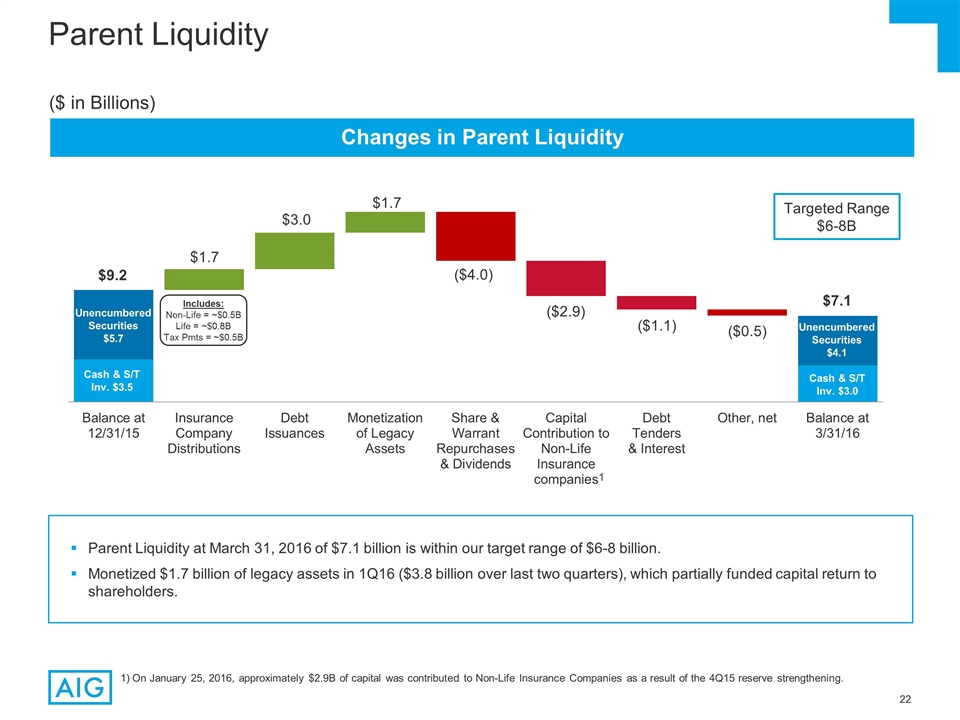
Parent Liquidity On January 25, 2016, approximately $2.9B of capital was contributed to Non-Life Insurance Companies as a result of the 4Q15 reserve strengthening. Changes in Parent Liquidity Cash & S/T Inv. $3.5 Unencumbered Securities $5.7 $9.2 1 Unencumbered Securities $4.1 Cash & S/T Inv. $3.0 $7.1 ($4.0) ($2.9) ($1.1) ($0.5) Includes: Non-Life = ~$0.5B Life = ~$0.8B Tax Pmts = ~$0.5B ($ in Billions) Parent Liquidity at March 31, 2016 of $7.1 billion is within our target range of $6-8 billion. Monetized $1.7 billion of legacy assets in 1Q16 ($3.8 billion over last two quarters), which partially funded capital return to shareholders.
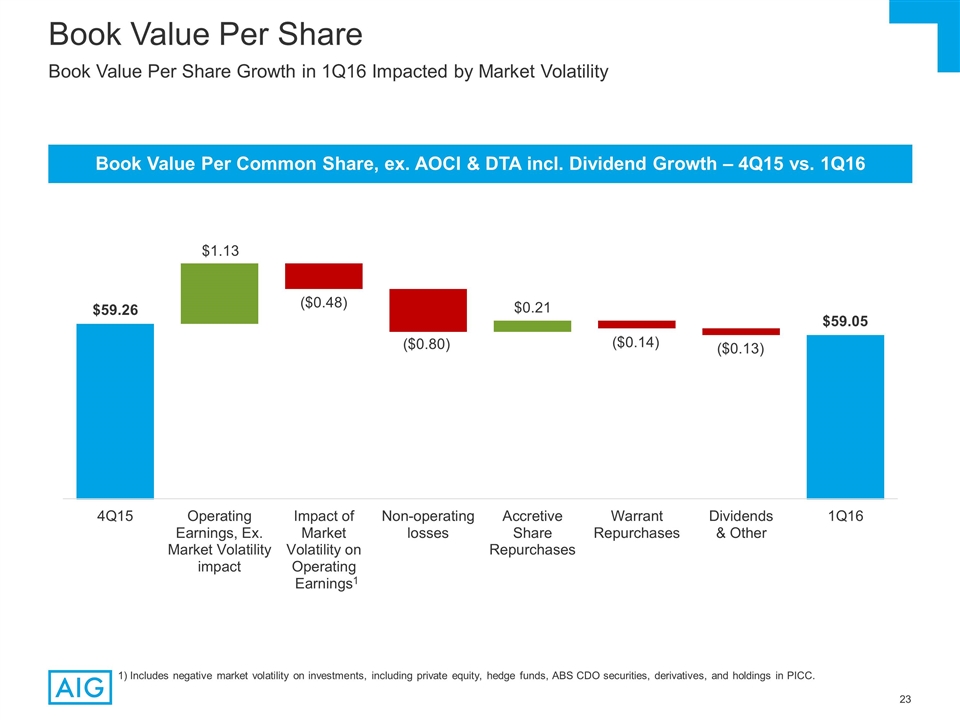
Book Value Per Share Book Value Per Share Growth in 1Q16 Impacted by Market Volatility Includes negative market volatility on investments, including private equity, hedge funds, ABS CDO securities, derivatives, and holdings in PICC. $59.26 $1.13 ($0.48) $0.21 ($0.80) $59.05 Book Value Per Common Share, ex. AOCI & DTA incl. Dividend Growth – 4Q15 vs. 1Q16 ($0.14) 1 ($0.13)
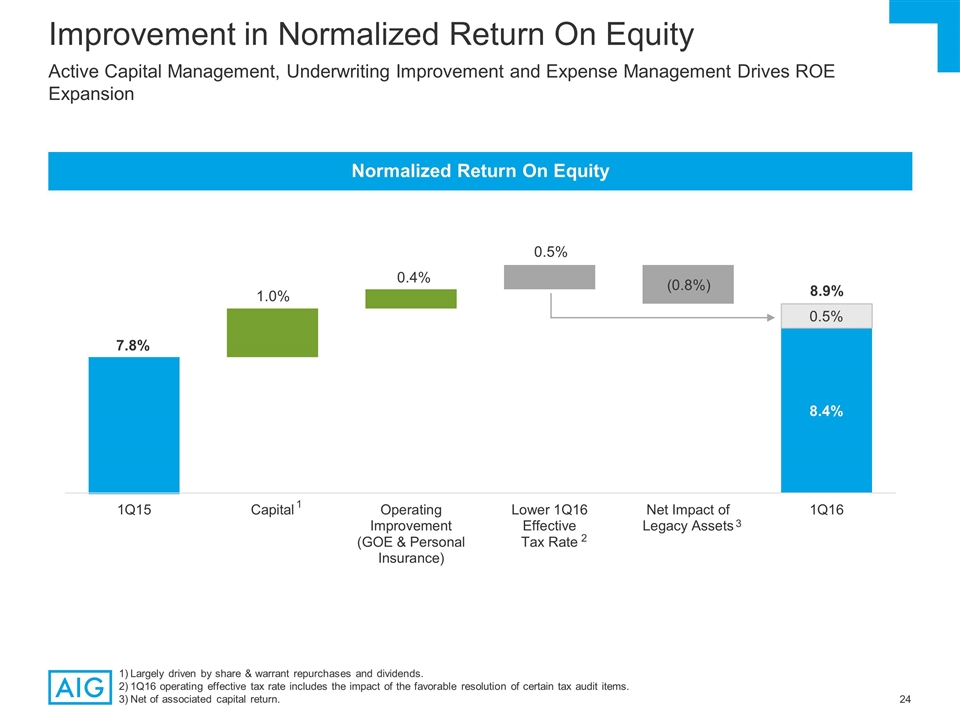
Improvement in Normalized Return On Equity Active Capital Management, Underwriting Improvement and Expense Management Drives ROE Expansion Largely driven by share & warrant repurchases and dividends. 1Q16 operating effective tax rate includes the impact of the favorable resolution of certain tax audit items. Net of associated capital return. Normalized Return On Equity 2 7.8% 8.9% 1.0% 0.4% 0.5% (0.8%) 3 1
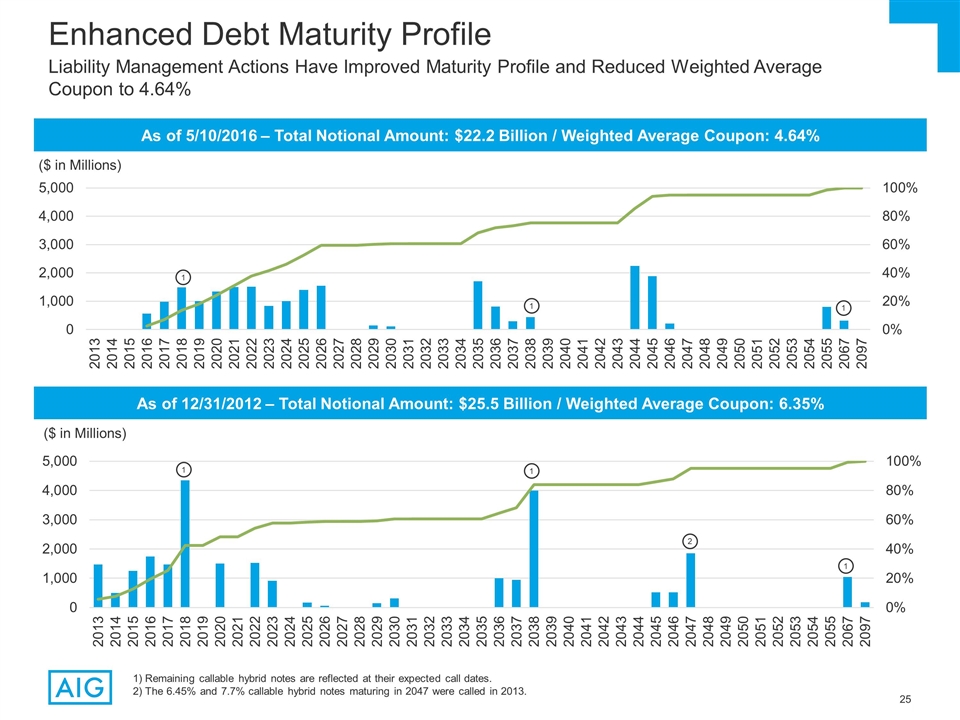
As of 12/31/2012 – Total Notional Amount: $25.5 Billion / Weighted Average Coupon: 6.35% As of 5/10/2016 – Total Notional Amount: $22.2 Billion / Weighted Average Coupon: 4.64% ($ in Millions) ($ in Millions) 1 1 1 2 Remaining callable hybrid notes are reflected at their expected call dates. The 6.45% and 7.7% callable hybrid notes maturing in 2047 were called in 2013. Enhanced Debt Maturity Profile Liability Management Actions Have Improved Maturity Profile and Reduced Weighted Average Coupon to 4.64% 1 1 1
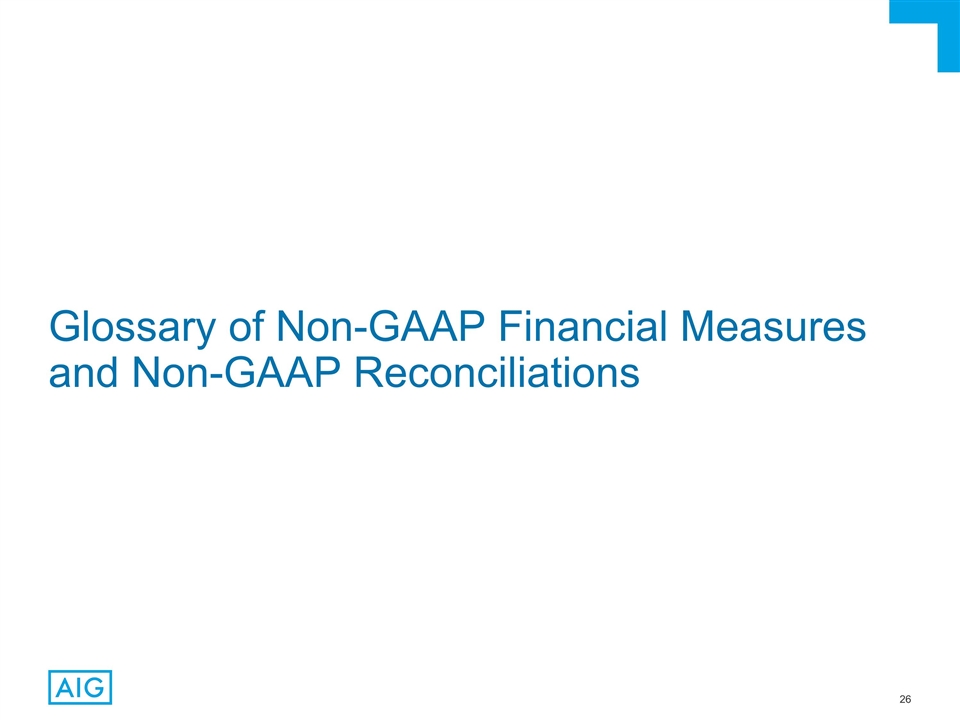
Glossary of Non-GAAP Financial Measures and Non-GAAP Reconciliations
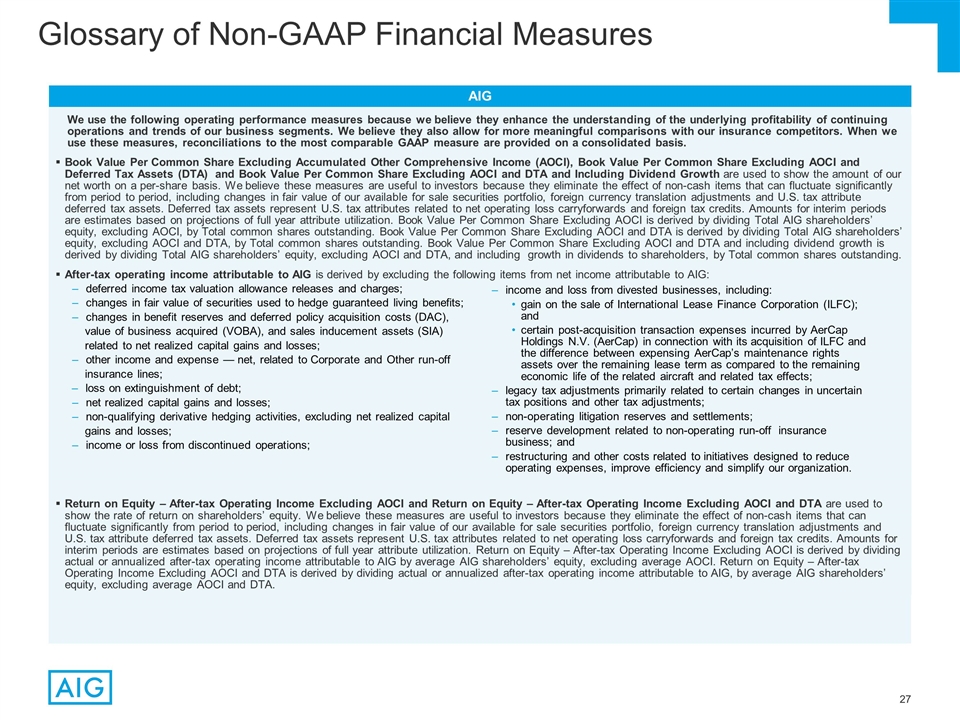
Glossary of Non-GAAP Financial Measures We use the following operating performance measures because we believe they enhance the understanding of the underlying profitability of continuing operations and trends of our business segments. We believe they also allow for more meaningful comparisons with our insurance competitors. When we use these measures, reconciliations to the most comparable GAAP measure are provided on a consolidated basis. Book Value Per Common Share Excluding Accumulated Other Comprehensive Income (AOCI), Book Value Per Common Share Excluding AOCI and Deferred Tax Assets (DTA) and Book Value Per Common Share Excluding AOCI and DTA and Including Dividend Growth are used to show the amount of our net worth on a per-share basis. We believe these measures are useful to investors because they eliminate the effect of non-cash items that can fluctuate significantly from period to period, including changes in fair value of our available for sale securities portfolio, foreign currency translation adjustments and U.S. tax attribute deferred tax assets. Deferred tax assets represent U.S. tax attributes related to net operating loss carryforwards and foreign tax credits. Amounts for interim periods are estimates based on projections of full year attribute utilization. Book Value Per Common Share Excluding AOCI is derived by dividing Total AIG shareholders’ equity, excluding AOCI, by Total common shares outstanding. Book Value Per Common Share Excluding AOCI and DTA is derived by dividing Total AIG shareholders’ equity, excluding AOCI and DTA, by Total common shares outstanding. Book Value Per Common Share Excluding AOCI and DTA and including dividend growth is derived by dividing Total AIG shareholders’ equity, excluding AOCI and DTA, and including growth in dividends to shareholders, by Total common shares outstanding. After-tax operating income attributable to AIG is derived by excluding the following items from net income attributable to AIG: deferred income tax valuation allowance releases and charges; changes in fair value of securities used to hedge guaranteed living benefits; changes in benefit reserves and deferred policy acquisition costs (DAC), value of business acquired (VOBA), and sales inducement assets (SIA) related to net realized capital gains and losses; other income and expense — net, related to Corporate and Other run-off insurance lines; loss on extinguishment of debt; net realized capital gains and losses; non-qualifying derivative hedging activities, excluding net realized capital gains and losses; income or loss from discontinued operations; Return on Equity – After-tax Operating Income Excluding AOCI and Return on Equity – After-tax Operating Income Excluding AOCI and DTA are used to show the rate of return on shareholders’ equity. We believe these measures are useful to investors because they eliminate the effect of non-cash items that can fluctuate significantly from period to period, including changes in fair value of our available for sale securities portfolio, foreign currency translation adjustments and U.S. tax attribute deferred tax assets. Deferred tax assets represent U.S. tax attributes related to net operating loss carryforwards and foreign tax credits. Amounts for interim periods are estimates based on projections of full year attribute utilization. Return on Equity – After-tax Operating Income Excluding AOCI is derived by dividing actual or annualized after-tax operating income attributable to AIG by average AIG shareholders’ equity, excluding average AOCI. Return on Equity – After-tax Operating Income Excluding AOCI and DTA is derived by dividing actual or annualized after-tax operating income attributable to AIG, by average AIG shareholders’ equity, excluding average AOCI and DTA. AIG income and loss from divested businesses, including: gain on the sale of International Lease Finance Corporation (ILFC); and certain post-acquisition transaction expenses incurred by AerCap Holdings N.V. (AerCap) in connection with its acquisition of ILFC and the difference between expensing AerCap’s maintenance rights assets over the remaining lease term as compared to the remaining economic life of the related aircraft and related tax effects; legacy tax adjustments primarily related to certain changes in uncertain tax positions and other tax adjustments; non-operating litigation reserves and settlements; reserve development related to non-operating run-off insurance business; and restructuring and other costs related to initiatives designed to reduce operating expenses, improve efficiency and simplify our organization.
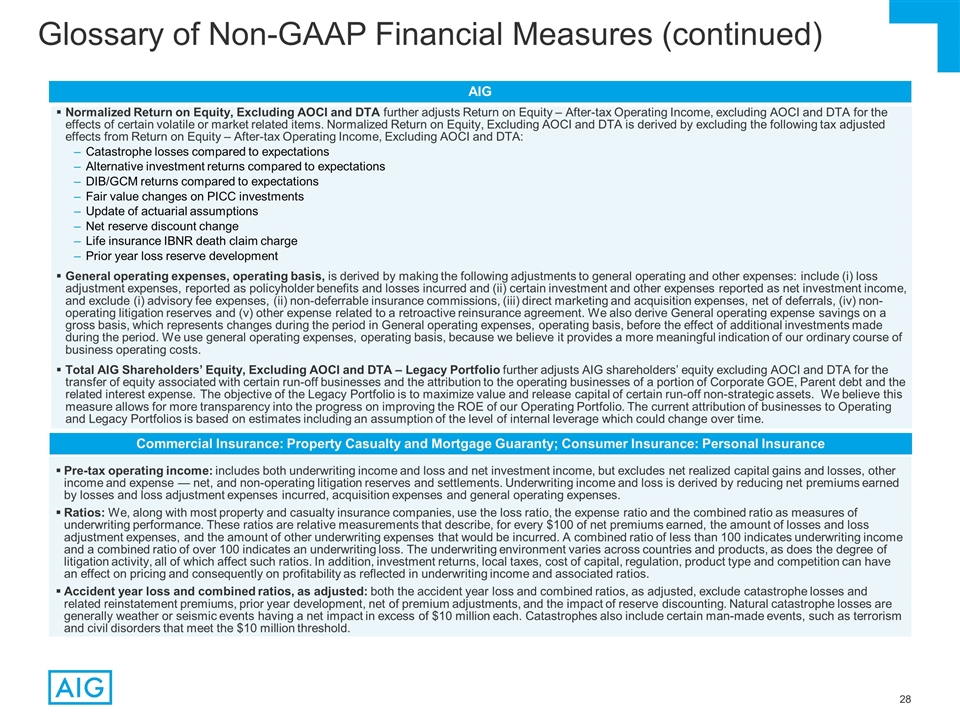
Glossary of Non-GAAP Financial Measures (continued) Pre-tax operating income: includes both underwriting income and loss and net investment income, but excludes net realized capital gains and losses, other income and expense — net, and non-operating litigation reserves and settlements. Underwriting income and loss is derived by reducing net premiums earned by losses and loss adjustment expenses incurred, acquisition expenses and general operating expenses. Ratios: We, along with most property and casualty insurance companies, use the loss ratio, the expense ratio and the combined ratio as measures of underwriting performance. These ratios are relative measurements that describe, for every $100 of net premiums earned, the amount of losses and loss adjustment expenses, and the amount of other underwriting expenses that would be incurred. A combined ratio of less than 100 indicates underwriting income and a combined ratio of over 100 indicates an underwriting loss. The underwriting environment varies across countries and products, as does the degree of litigation activity, all of which affect such ratios. In addition, investment returns, local taxes, cost of capital, regulation, product type and competition can have an effect on pricing and consequently on profitability as reflected in underwriting income and associated ratios. Accident year loss and combined ratios, as adjusted: both the accident year loss and combined ratios, as adjusted, exclude catastrophe losses and related reinstatement premiums, prior year development, net of premium adjustments, and the impact of reserve discounting. Natural catastrophe losses are generally weather or seismic events having a net impact in excess of $10 million each. Catastrophes also include certain man-made events, such as terrorism and civil disorders that meet the $10 million threshold. Normalized Return on Equity, Excluding AOCI and DTA further adjusts Return on Equity – After-tax Operating Income, excluding AOCI and DTA for the effects of certain volatile or market related items. Normalized Return on Equity, Excluding AOCI and DTA is derived by excluding the following tax adjusted effects from Return on Equity – After-tax Operating Income, Excluding AOCI and DTA: Catastrophe losses compared to expectations Alternative investment returns compared to expectations DIB/GCM returns compared to expectations Fair value changes on PICC investments Update of actuarial assumptions Net reserve discount change Life insurance IBNR death claim charge Prior year loss reserve development General operating expenses, operating basis, is derived by making the following adjustments to general operating and other expenses: include (i) loss adjustment expenses, reported as policyholder benefits and losses incurred and (ii) certain investment and other expenses reported as net investment income, and exclude (i) advisory fee expenses, (ii) non-deferrable insurance commissions, (iii) direct marketing and acquisition expenses, net of deferrals, (iv) non-operating litigation reserves and (v) other expense related to a retroactive reinsurance agreement. We also derive General operating expense savings on a gross basis, which represents changes during the period in General operating expenses, operating basis, before the effect of additional investments made during the period. We use general operating expenses, operating basis, because we believe it provides a more meaningful indication of our ordinary course of business operating costs. Total AIG Shareholders’ Equity, Excluding AOCI and DTA – Legacy Portfolio further adjusts AIG shareholders’ equity excluding AOCI and DTA for the transfer of equity associated with certain run-off businesses and the attribution to the operating businesses of a portion of Corporate GOE, Parent debt and the related interest expense. The objective of the Legacy Portfolio is to maximize value and release capital of certain run-off non-strategic assets. We believe this measure allows for more transparency into the progress on improving the ROE of our Operating Portfolio. The current attribution of businesses to Operating and Legacy Portfolios is based on estimates including an assumption of the level of internal leverage which could change over time. AIG Commercial Insurance: Property Casualty and Mortgage Guaranty; Consumer Insurance: Personal Insurance
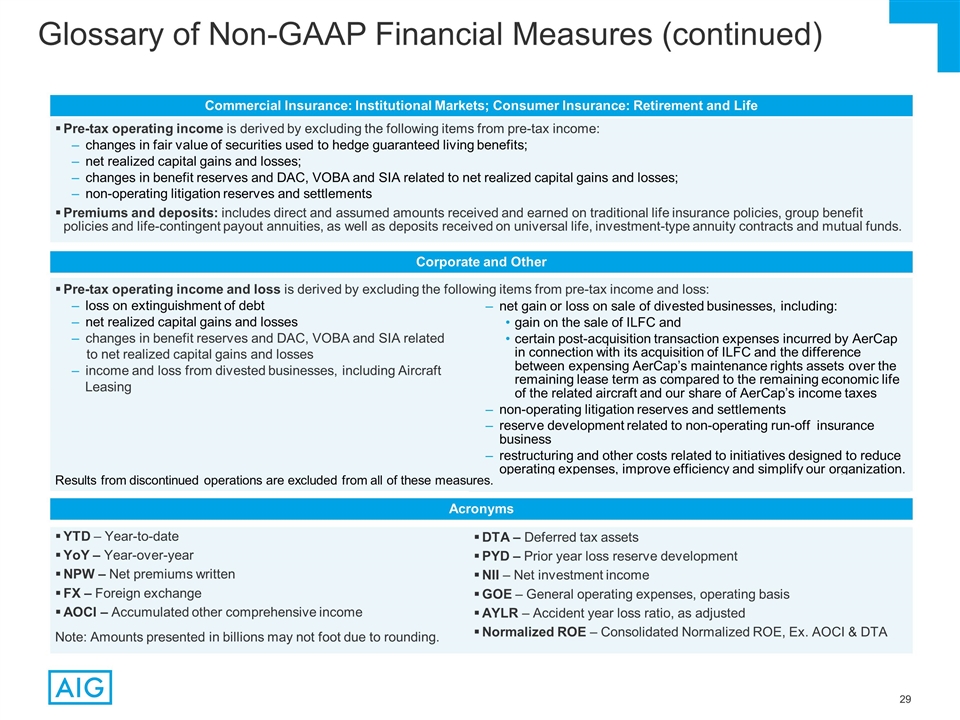
Glossary of Non-GAAP Financial Measures (continued) Pre-tax operating income and loss is derived by excluding the following items from pre-tax income and loss: loss on extinguishment of debt net realized capital gains and losses changes in benefit reserves and DAC, VOBA and SIA related to net realized capital gains and losses income and loss from divested businesses, including Aircraft Leasing Corporate and Other net gain or loss on sale of divested businesses, including: gain on the sale of ILFC and certain post-acquisition transaction expenses incurred by AerCap in connection with its acquisition of ILFC and the difference between expensing AerCap’s maintenance rights assets over the remaining lease term as compared to the remaining economic life of the related aircraft and our share of AerCap’s income taxes non-operating litigation reserves and settlements reserve development related to non-operating run-off insurance business restructuring and other costs related to initiatives designed to reduce operating expenses, improve efficiency and simplify our organization. Results from discontinued operations are excluded from all of these measures. Commercial Insurance: Institutional Markets; Consumer Insurance: Retirement and Life Pre-tax operating income is derived by excluding the following items from pre-tax income: changes in fair value of securities used to hedge guaranteed living benefits; net realized capital gains and losses; changes in benefit reserves and DAC, VOBA and SIA related to net realized capital gains and losses; non-operating litigation reserves and settlements Premiums and deposits: includes direct and assumed amounts received and earned on traditional life insurance policies, group benefit policies and life-contingent payout annuities, as well as deposits received on universal life, investment-type annuity contracts and mutual funds. Acronyms YTD – Year-to-date YoY – Year-over-year NPW – Net premiums written FX – Foreign exchange AOCI – Accumulated other comprehensive income DTA – Deferred tax assets PYD – Prior year loss reserve development NII – Net investment income GOE – General operating expenses, operating basis AYLR – Accident year loss ratio, as adjusted Normalized ROE – Consolidated Normalized ROE, Ex. AOCI & DTA Note: Amounts presented in billions may not foot due to rounding.
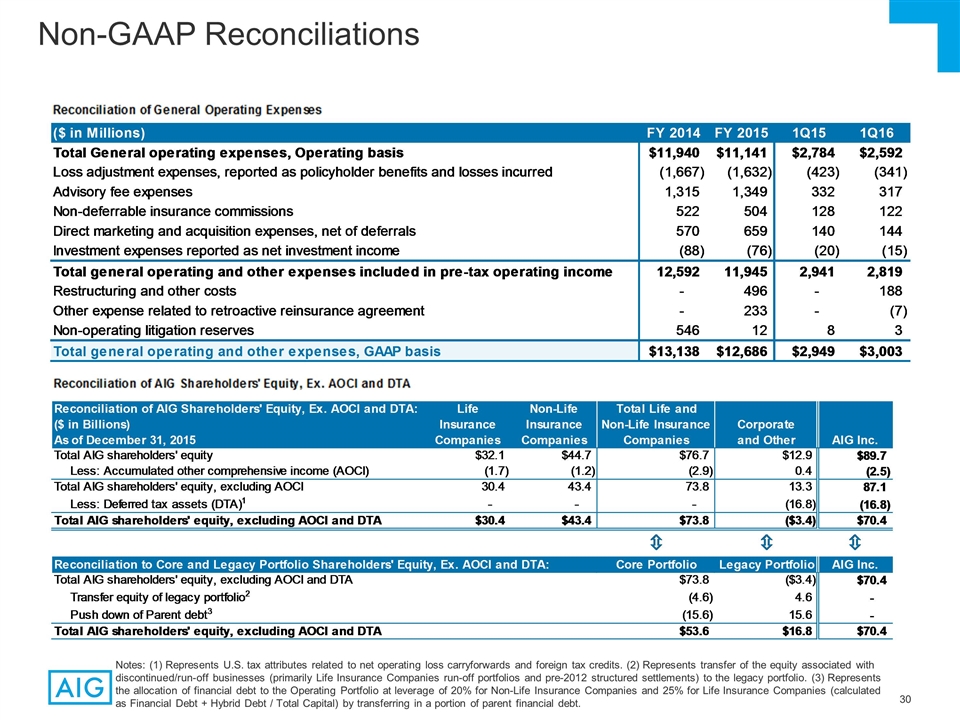
Non-GAAP Reconciliations Notes: (1) Represents U.S. tax attributes related to net operating loss carryforwards and foreign tax credits. (2) Represents transfer of the equity associated with discontinued/run-off businesses (primarily Life Insurance Companies run-off portfolios and pre-2012 structured settlements) to the legacy portfolio. (3) Represents the allocation of financial debt to the Operating Portfolio at leverage of 20% for Non-Life Insurance Companies and 25% for Life Insurance Companies (calculated as Financial Debt + Hybrid Debt / Total Capital) by transferring in a portion of parent financial debt.
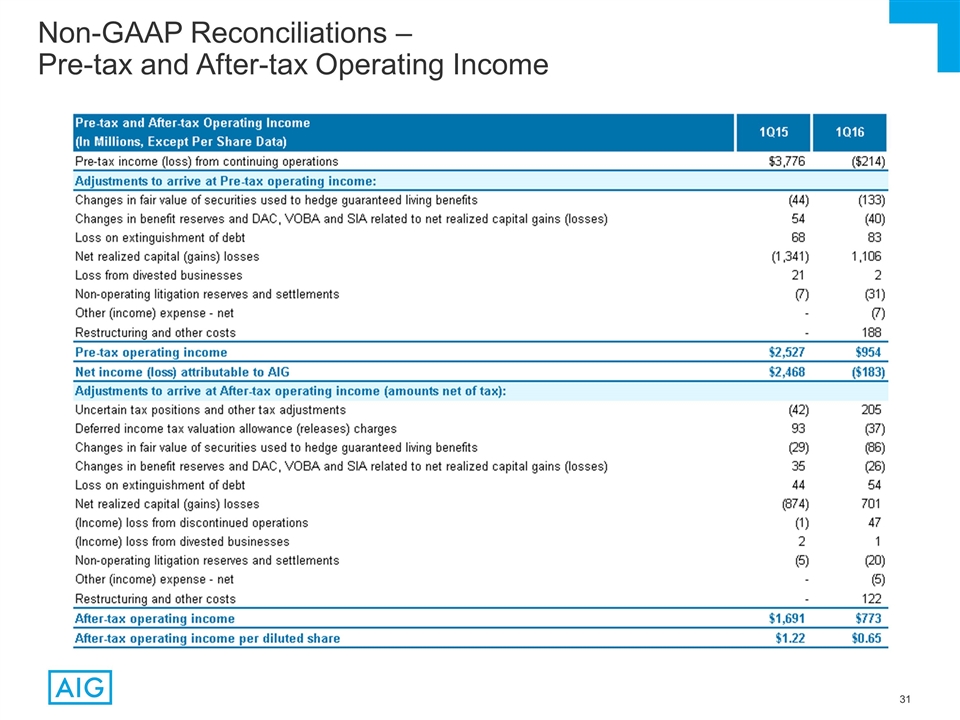
Non-GAAP Reconciliations – Pre-tax and After-tax Operating Income
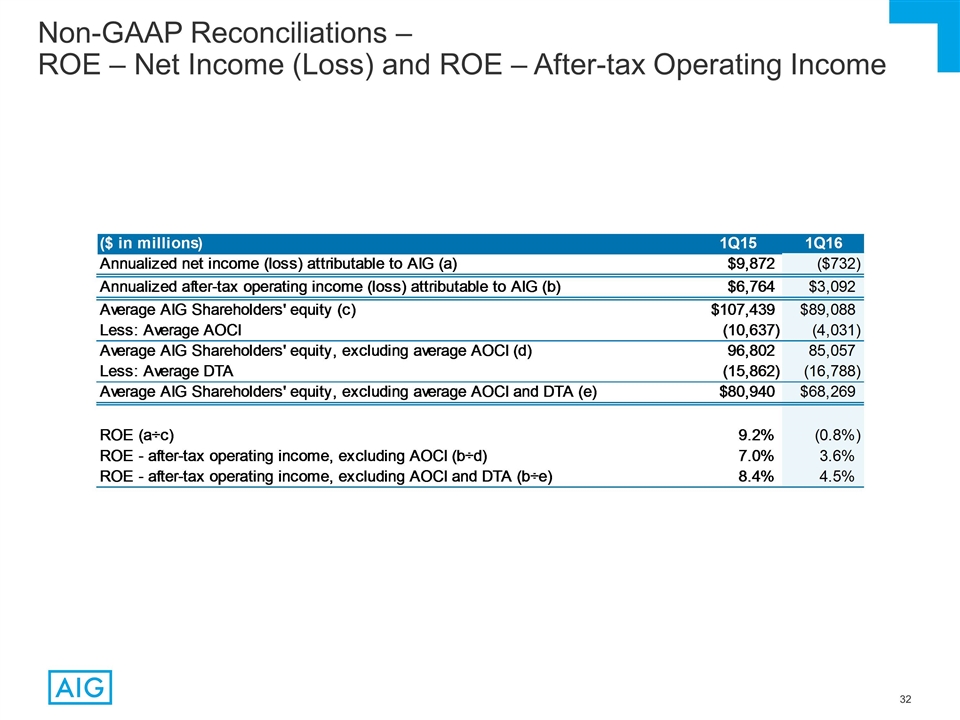
Non-GAAP Reconciliations – ROE – Net Income (Loss) and ROE – After-tax Operating Income 32
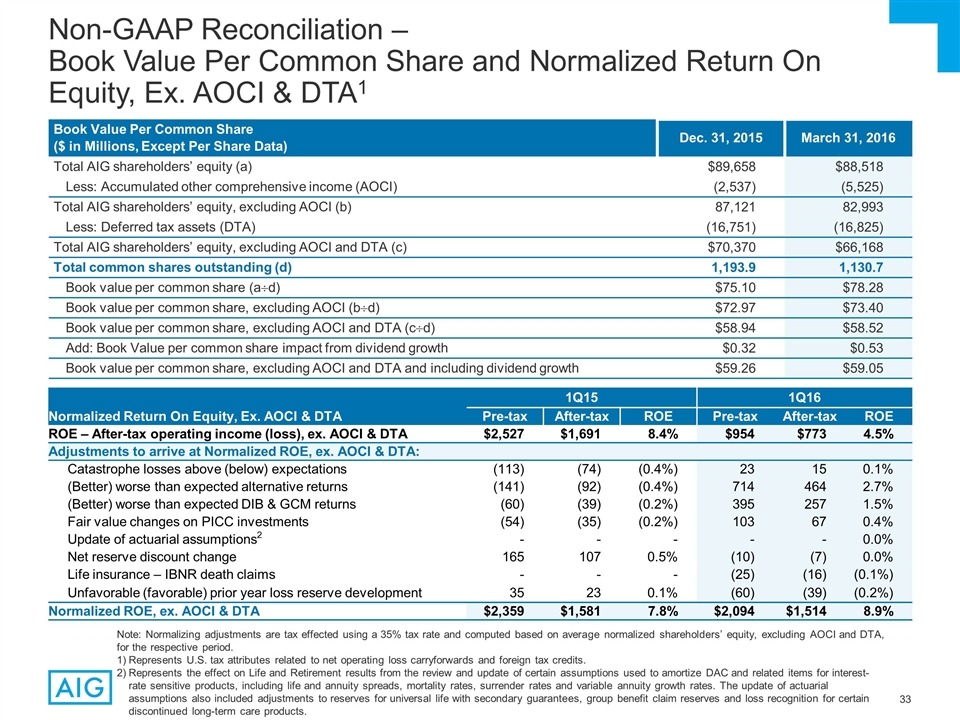
Non-GAAP Reconciliation – Book Value Per Common Share and Normalized Return On Equity, Ex. AOCI & DTA1 Book Value Per Common Share ($ in Millions, Except Per Share Data) Dec. 31, 2015 March 31, 2016 Total AIG shareholders’ equity (a) $89,658 $88,518 Less: Accumulated other comprehensive income (AOCI) (2,537) (5,525) Total AIG shareholders’ equity, excluding AOCI (b) 87,121 82,993 Less: Deferred tax assets (DTA) (16,751) (16,825) Total AIG shareholders’ equity, excluding AOCI and DTA (c) $70,370 $66,168 Total common shares outstanding (d) 1,193.9 1,130.7 Book value per common share (a¸d) $75.10 $78.28 Book value per common share, excluding AOCI (b¸d) $72.97 $73.40 Book value per common share, excluding AOCI and DTA (c¸d) $58.94 $58.52 Add: Book Value per common share impact from dividend growth $0.32 $0.53 Book value per common share, excluding AOCI and DTA and including dividend growth $59.26 $59.05 1Q15 1Q16 Normalized Return On Equity, Ex. AOCI & DTA Pre-tax After-tax ROE Pre-tax After-tax ROE ROE – After-tax operating income (loss), ex. AOCI & DTA $2,527 $1,691 8.4% $954 $773 4.5% Adjustments to arrive at Normalized ROE, ex. AOCI & DTA: Catastrophe losses above (below) expectations (113) (74) (0.4%) 23 15 0.1% (Better) worse than expected alternative returns (141) (92) (0.4%) 714 464 2.7% (Better) worse than expected DIB & GCM returns (60) (39) (0.2%) 395 257 1.5% Fair value changes on PICC investments (54) (35) (0.2%) 103 67 0.4% Update of actuarial assumptions2 - - - - - 0.0% Net reserve discount change 165 107 0.5% (10) (7) 0.0% Life insurance – IBNR death claims - - - (25) (16) (0.1%) Unfavorable (favorable) prior year loss reserve development 35 23 0.1% (60) (39) (0.2%) Normalized ROE, ex. AOCI & DTA $2,359 $1,581 7.8% $2,094 $1,514 8.9% Note: Normalizing adjustments are tax effected using a 35% tax rate and computed based on average normalized shareholders’ equity, excluding AOCI and DTA, for the respective period. Represents U.S. tax attributes related to net operating loss carryforwards and foreign tax credits. Represents the effect on Life and Retirement results from the review and update of certain assumptions used to amortize DAC and related items for interest-rate sensitive products, including life and annuity spreads, mortality rates, surrender rates and variable annuity growth rates. The update of actuarial assumptions also included adjustments to reserves for universal life with secondary guarantees, group benefit claim reserves and loss recognition for certain discontinued long-term care products.
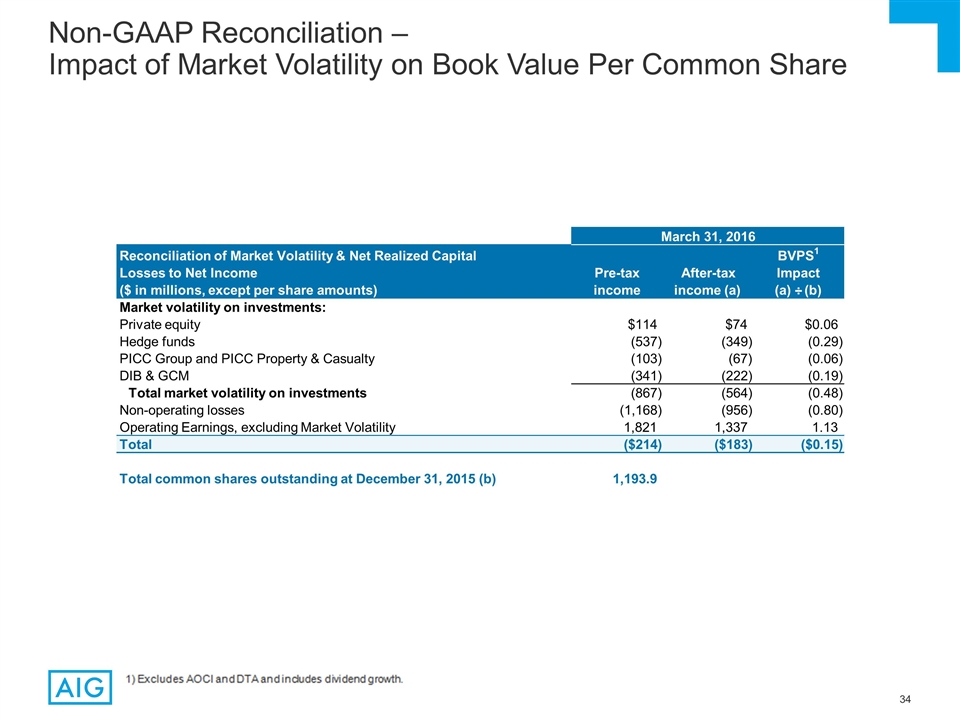
Non-GAAP Reconciliation – Impact of Market Volatility on Book Value Per Common Share Reconciliation of Market Volatility & Net Realized Capital Losses to Net Income ($ in millions, except per share amounts) Pre-tax income After-tax income (a) BVPS 1 Impact (a) ÷ (b) Market volatility on investments: Private equity $114 $74 $0.06 Hedge funds (537) (349) (0.29) PICC Group and PICC Property & Casualty (103) (67) (0.06) DIB & GCM (341) (222) (0.19) Total market volatility on investments (867) (564) (0.48) Non-operating losses (1,168) (956) (0.80) Operating Earnings, excluding Market Volatility 1,821 1,337 1.13 Total ($214) ($183) ($0.15) Total common shares outstanding at December 31, 2015 (b) 1,193.9 March 31, 2016
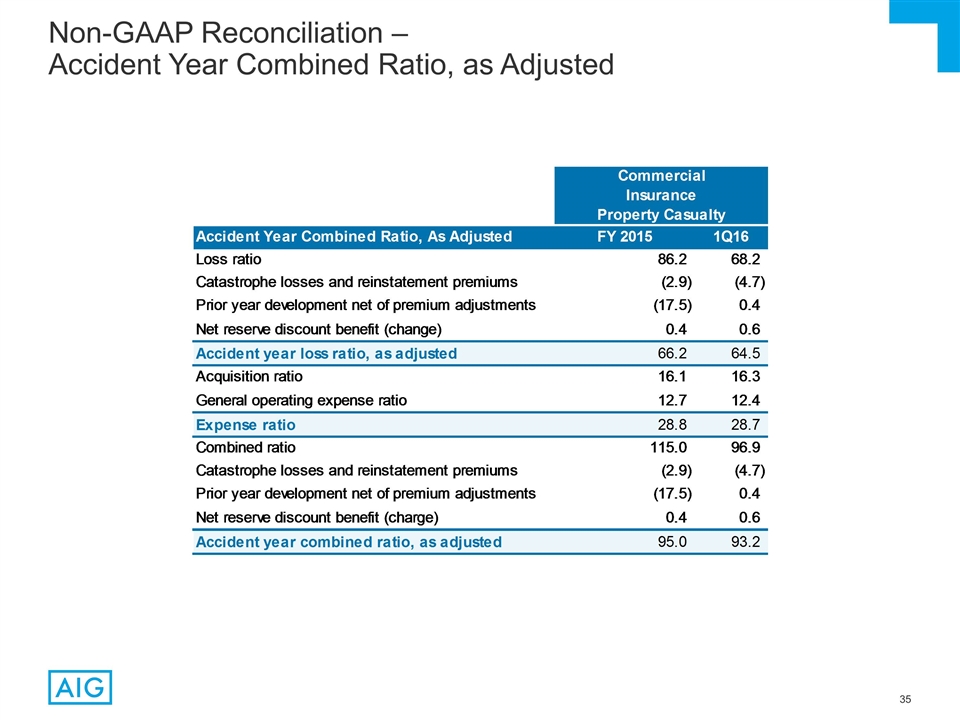
Non-GAAP Reconciliation – Accident Year Combined Ratio, as Adjusted